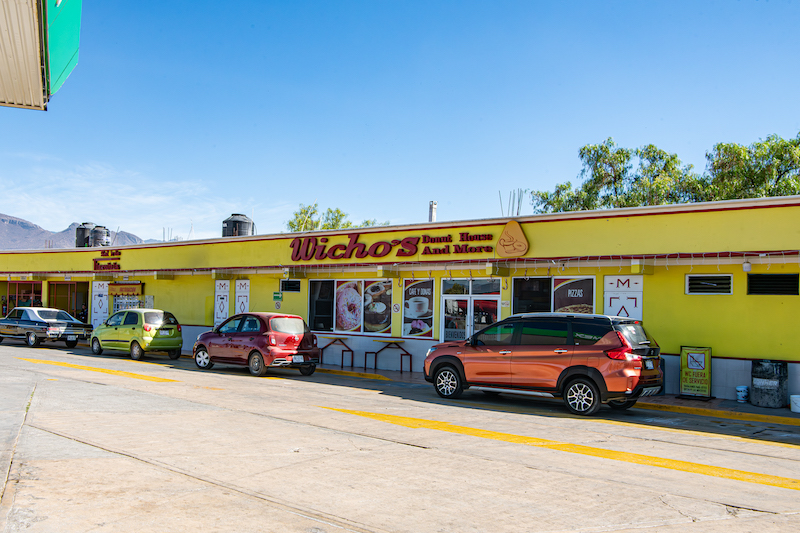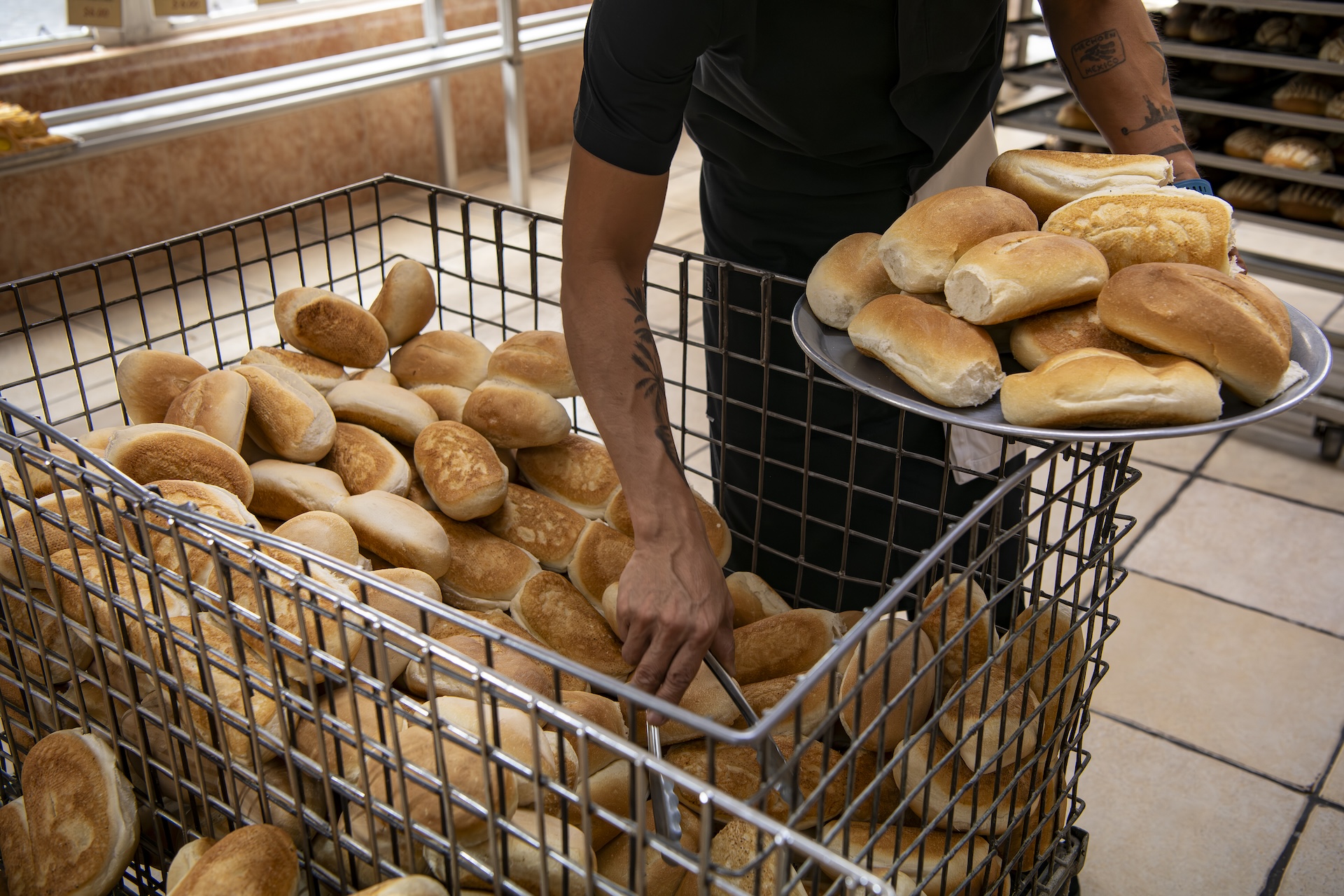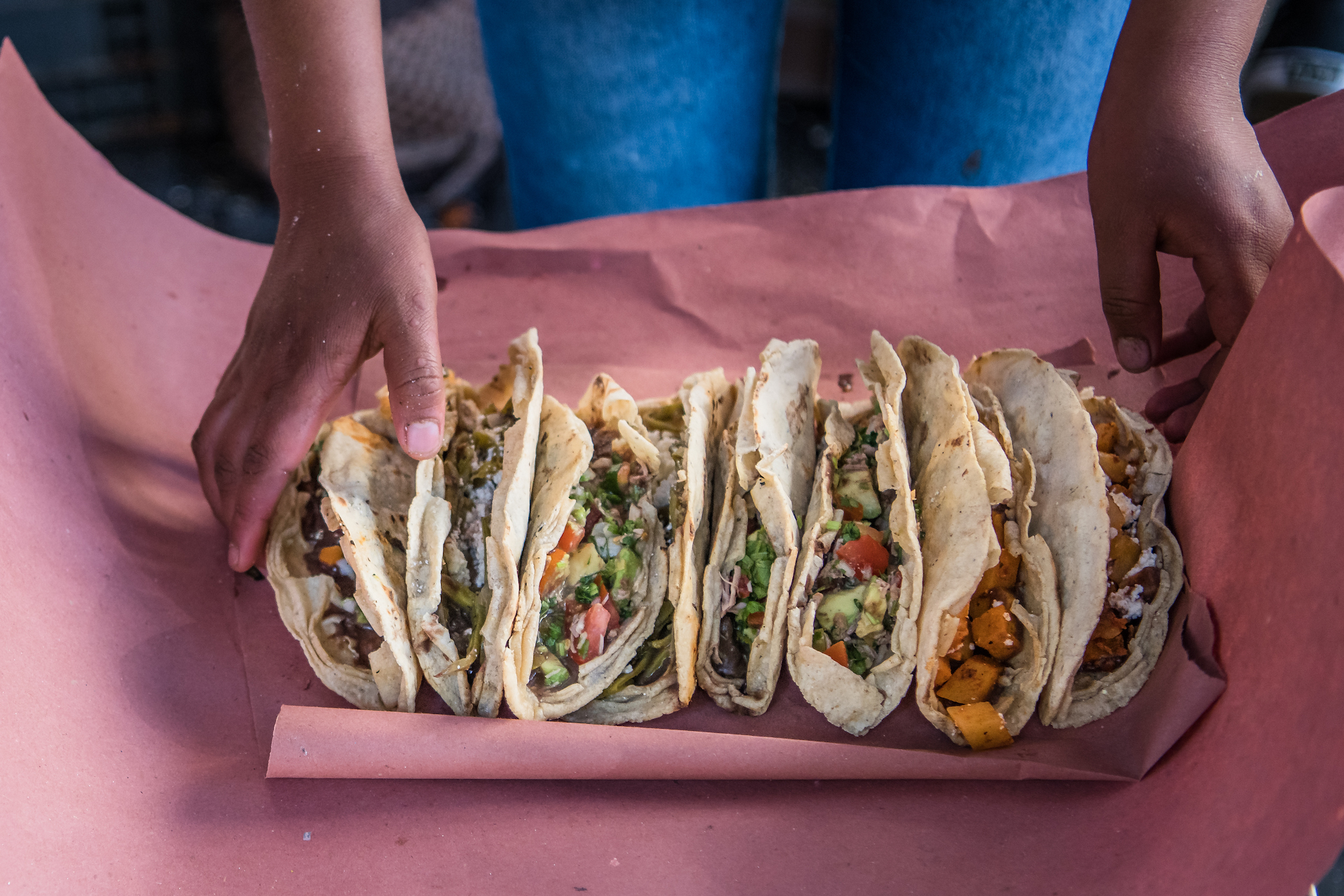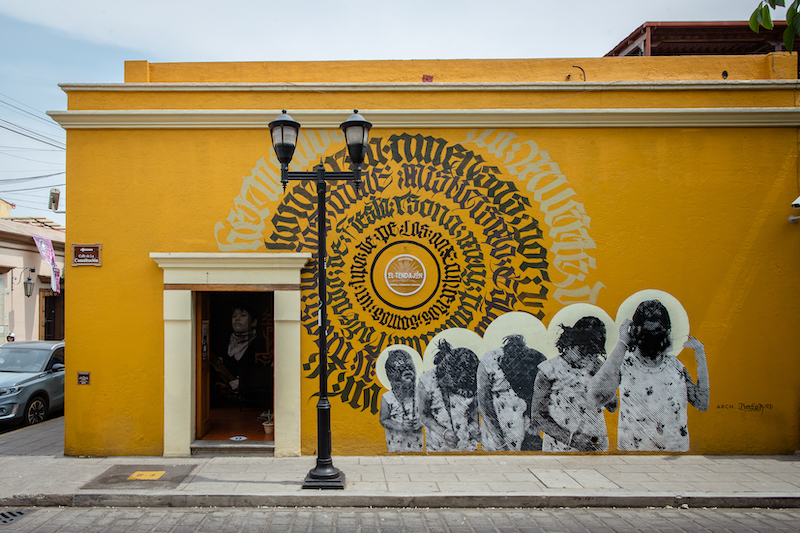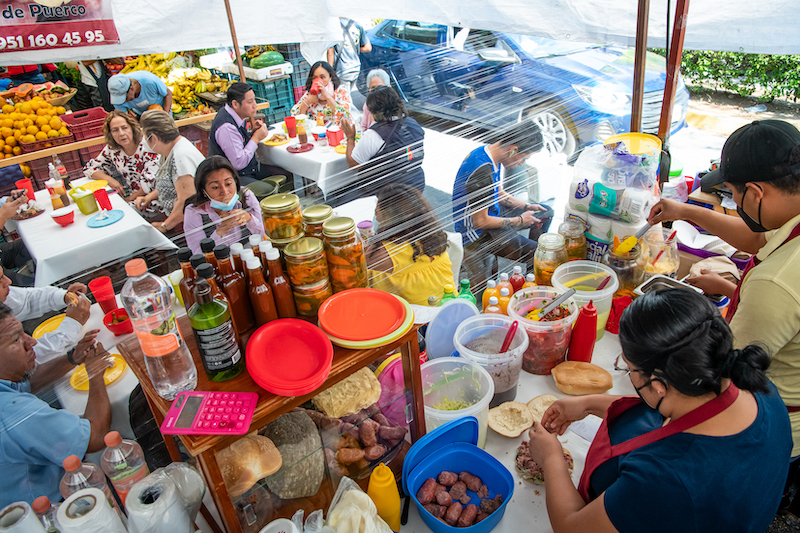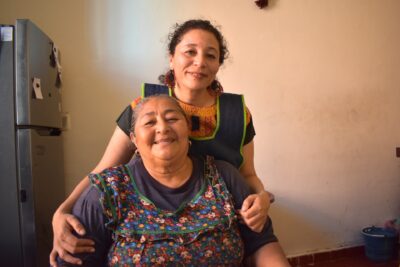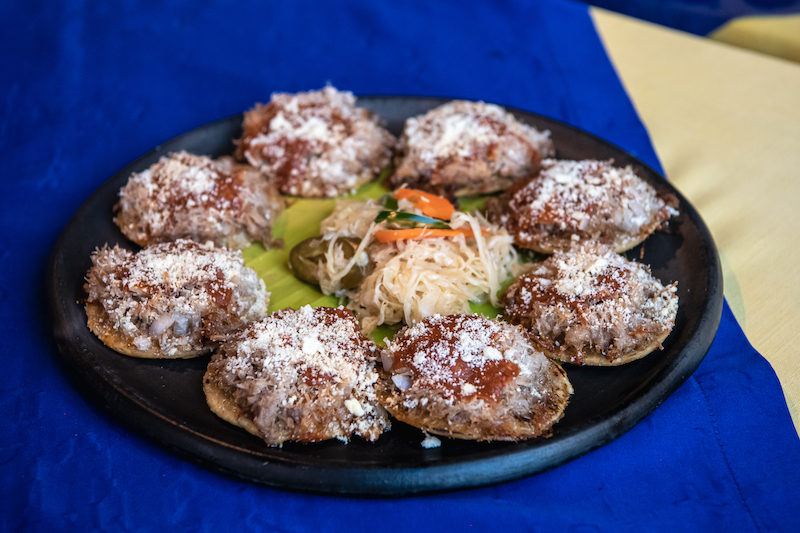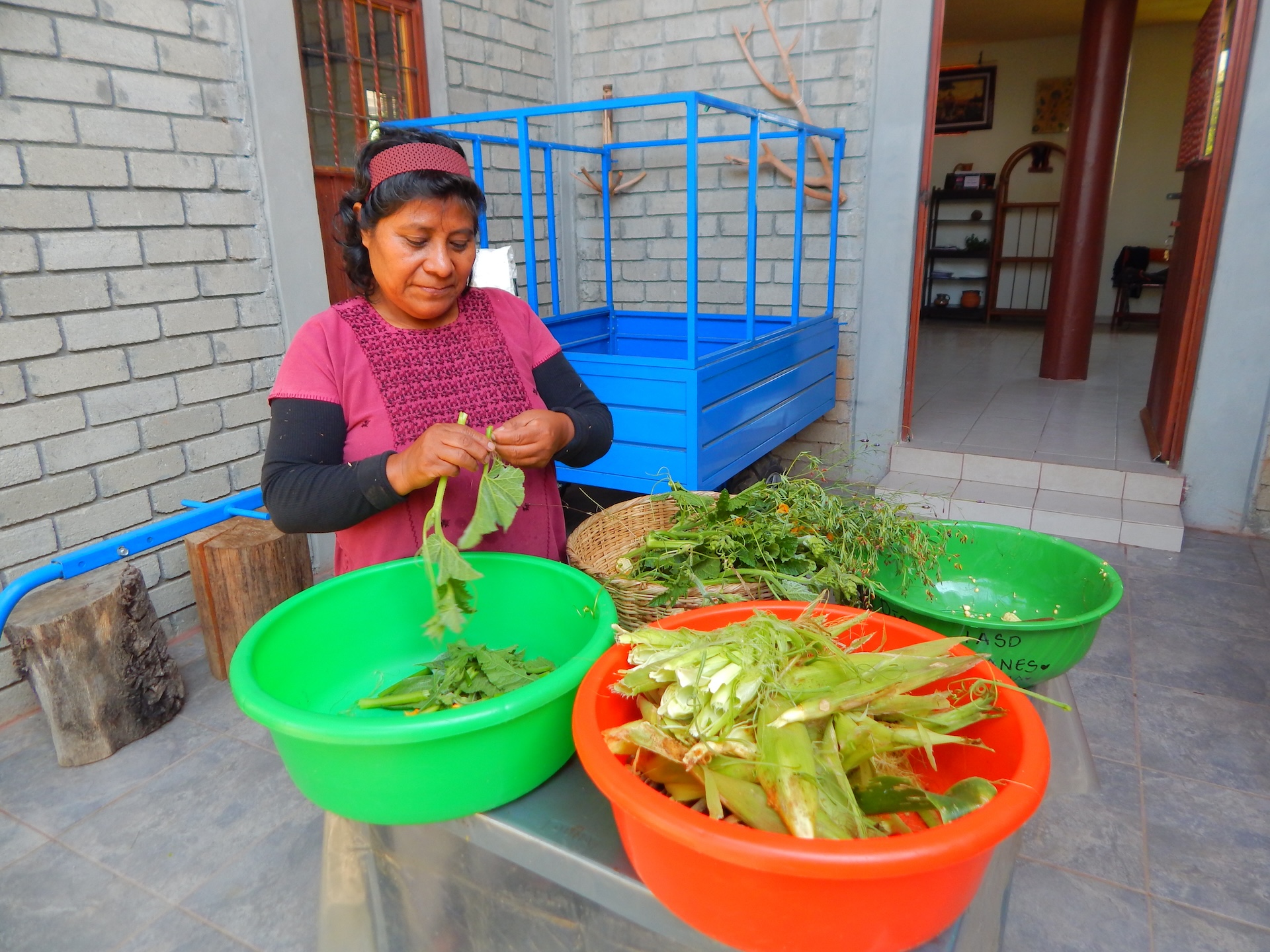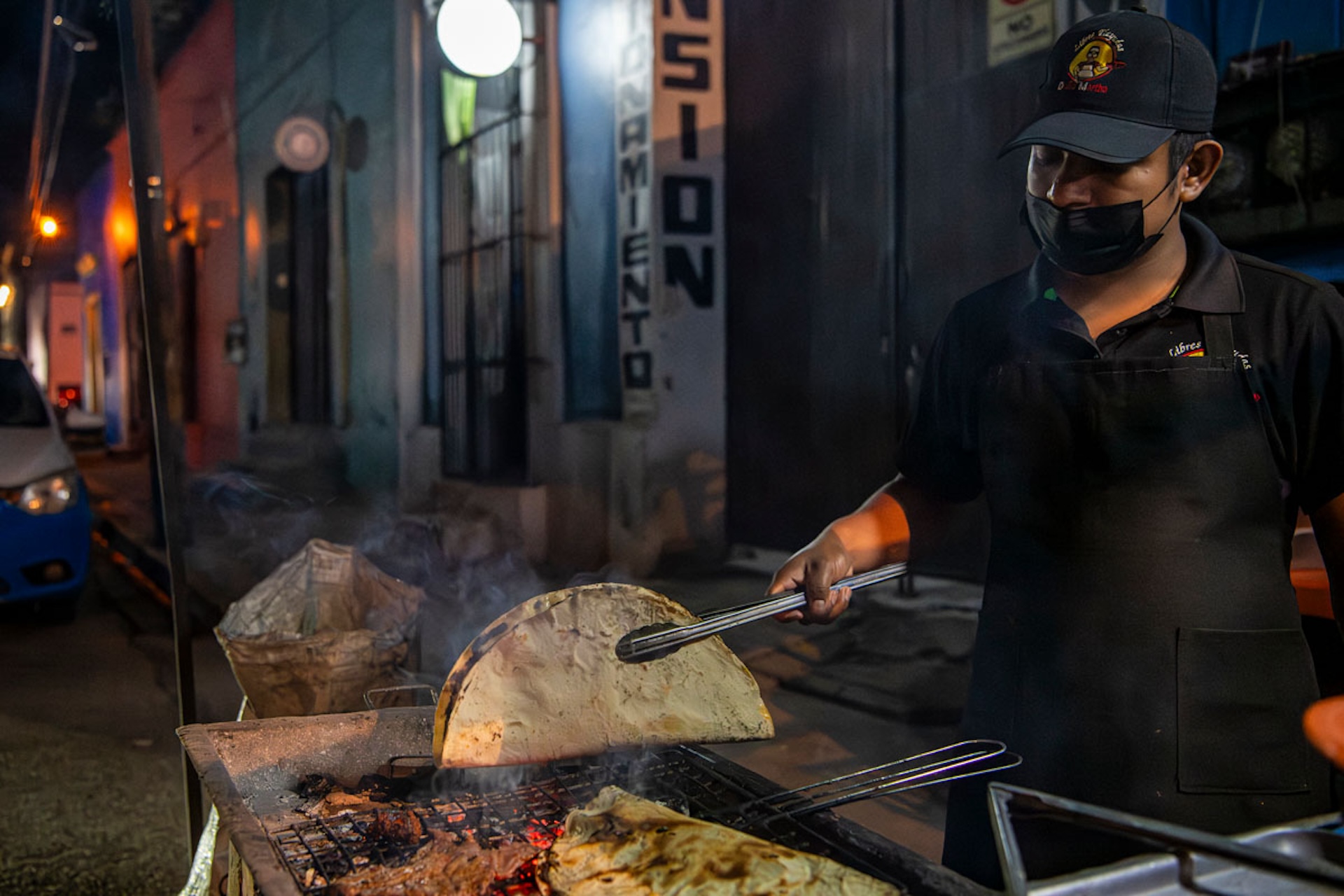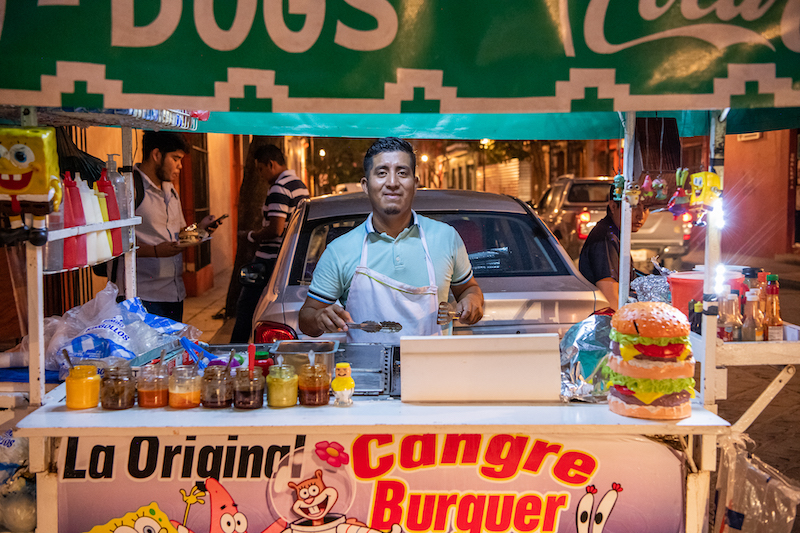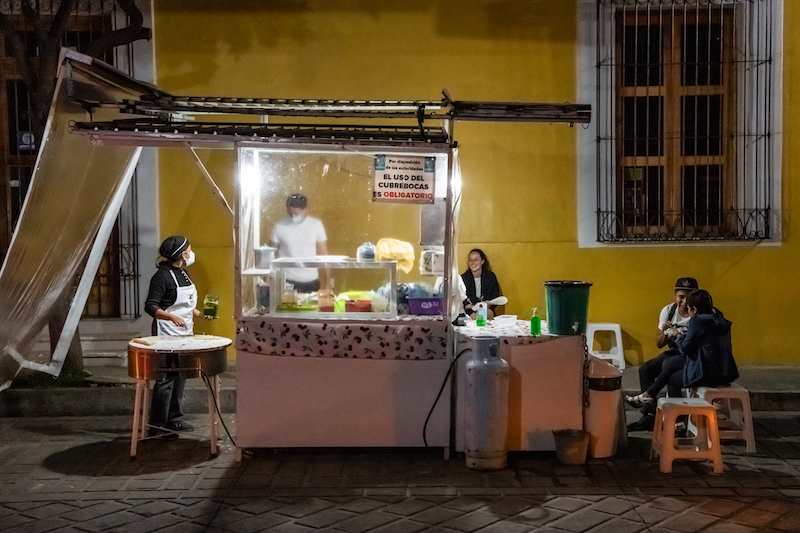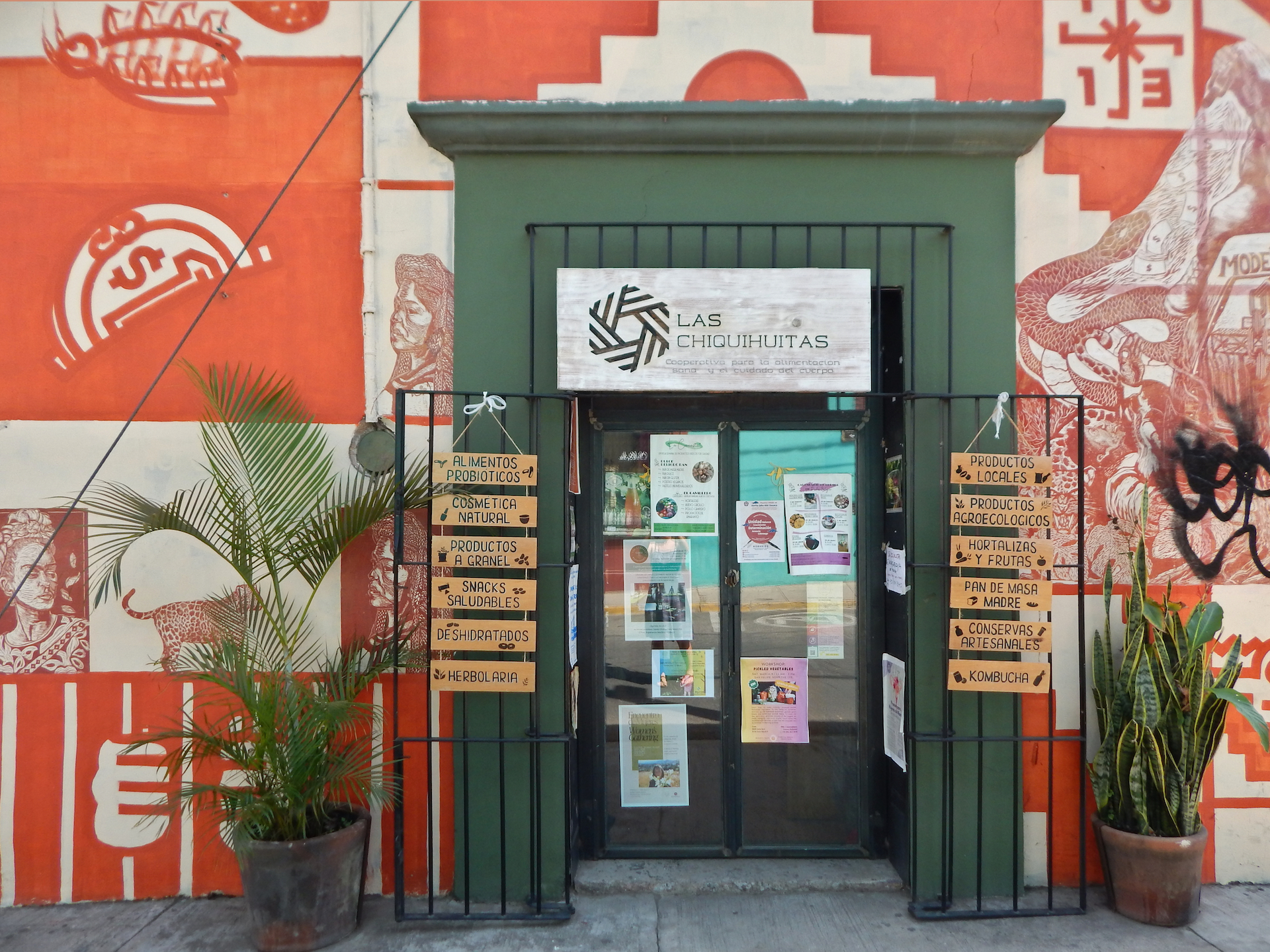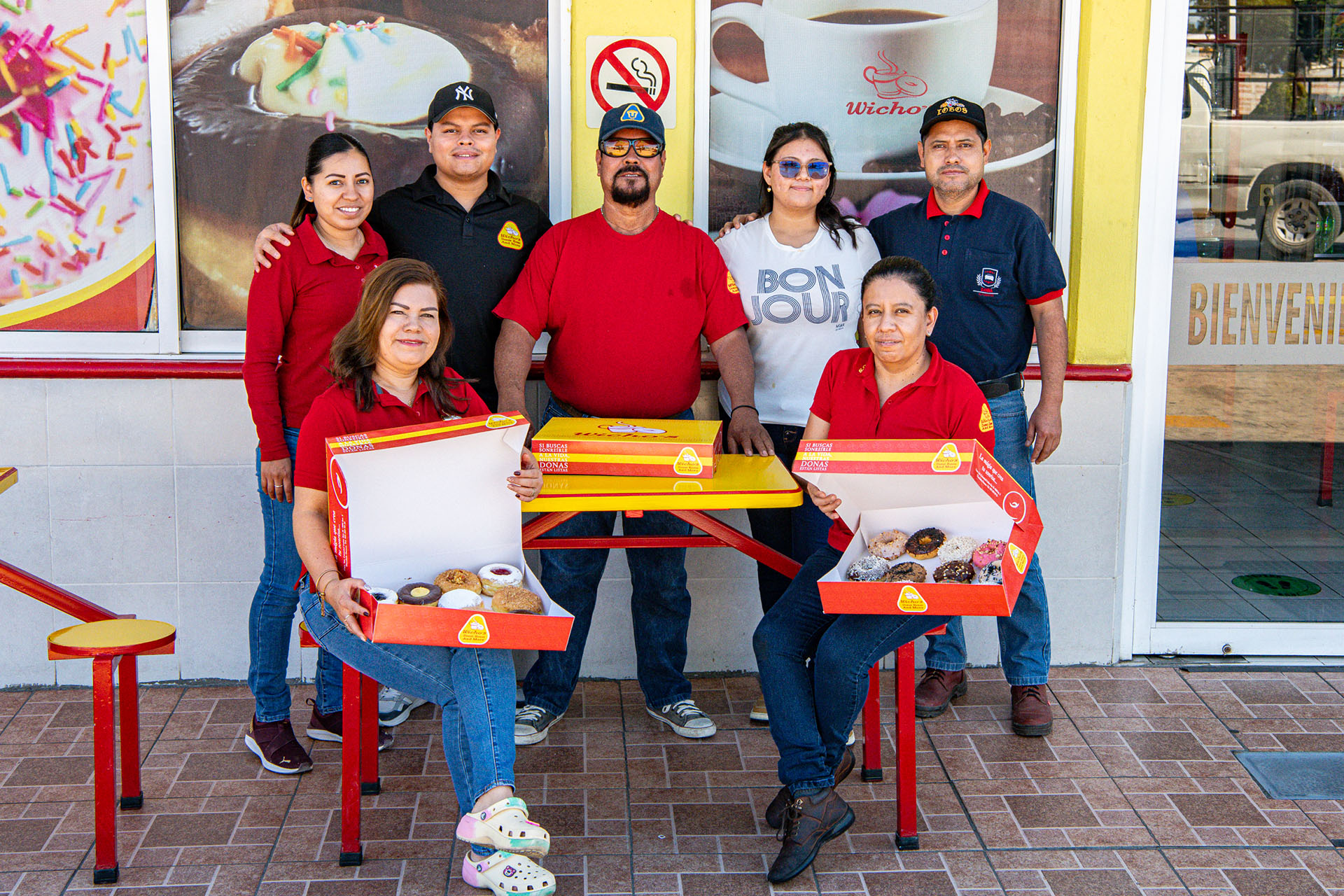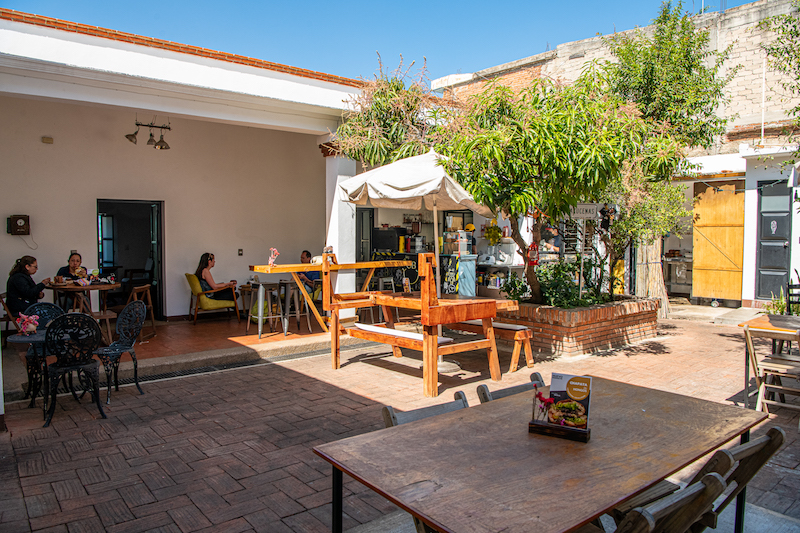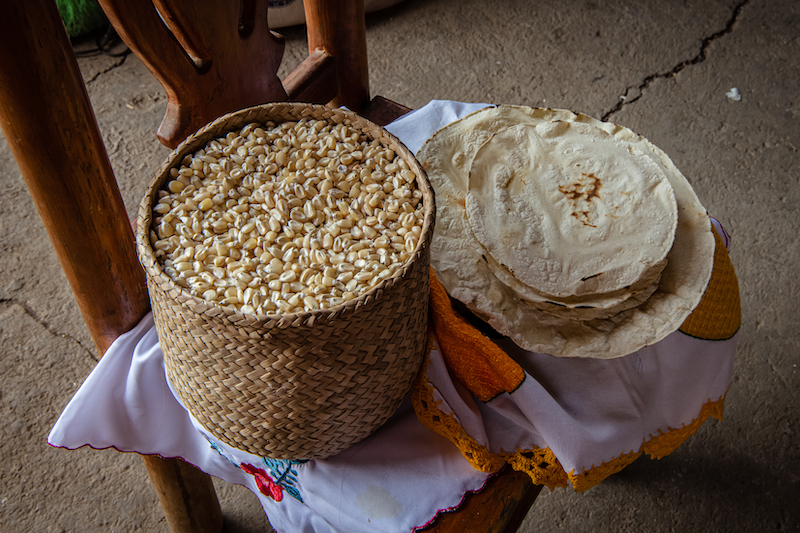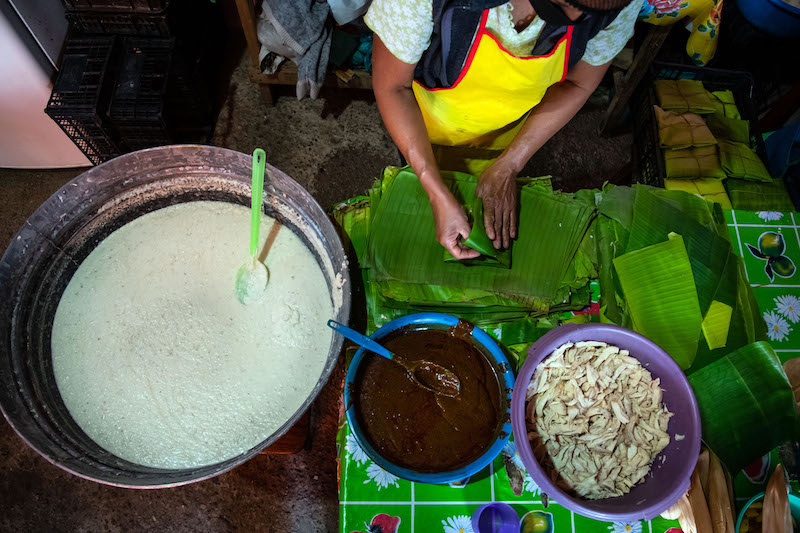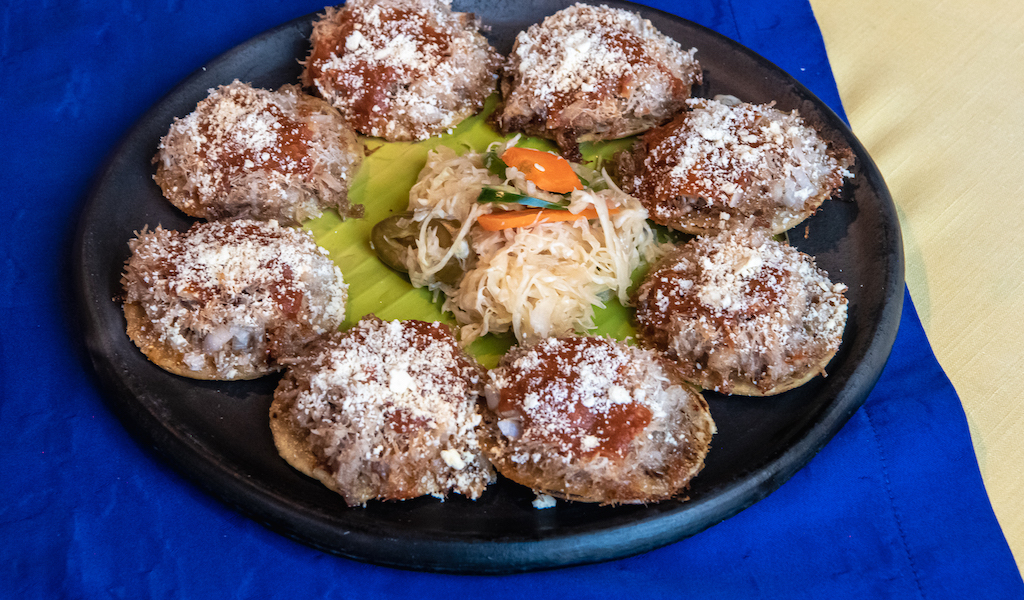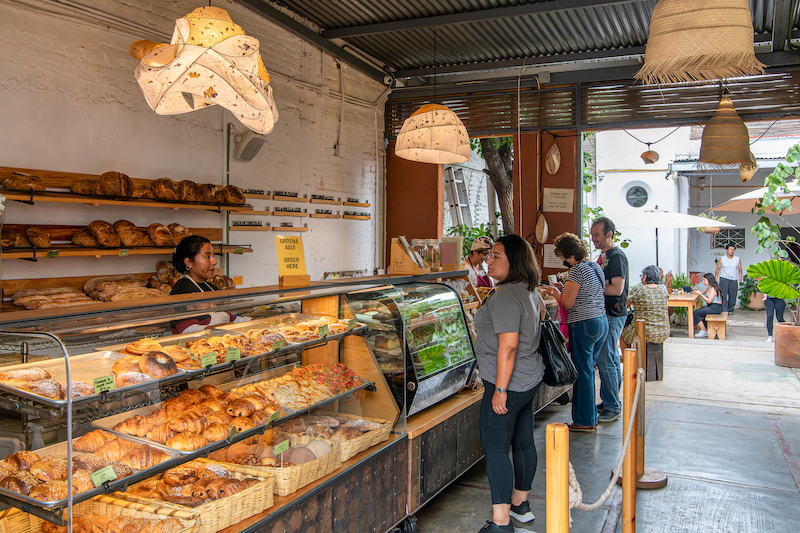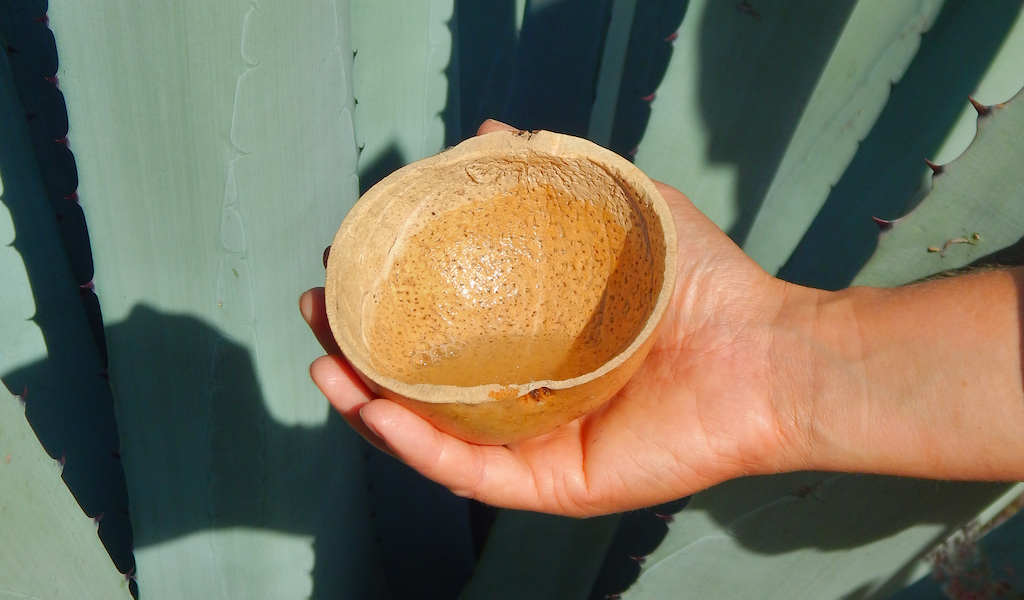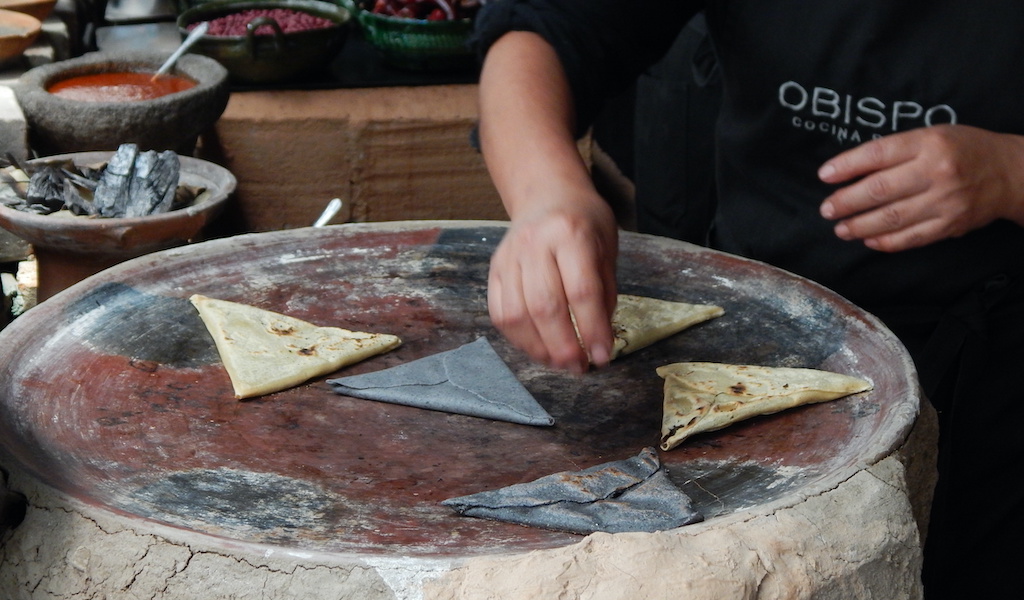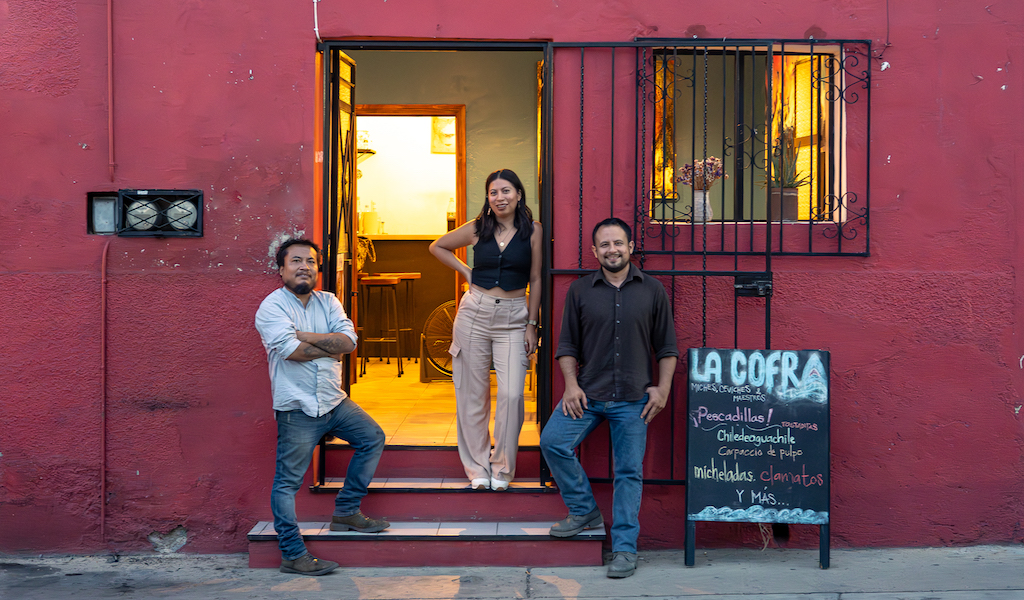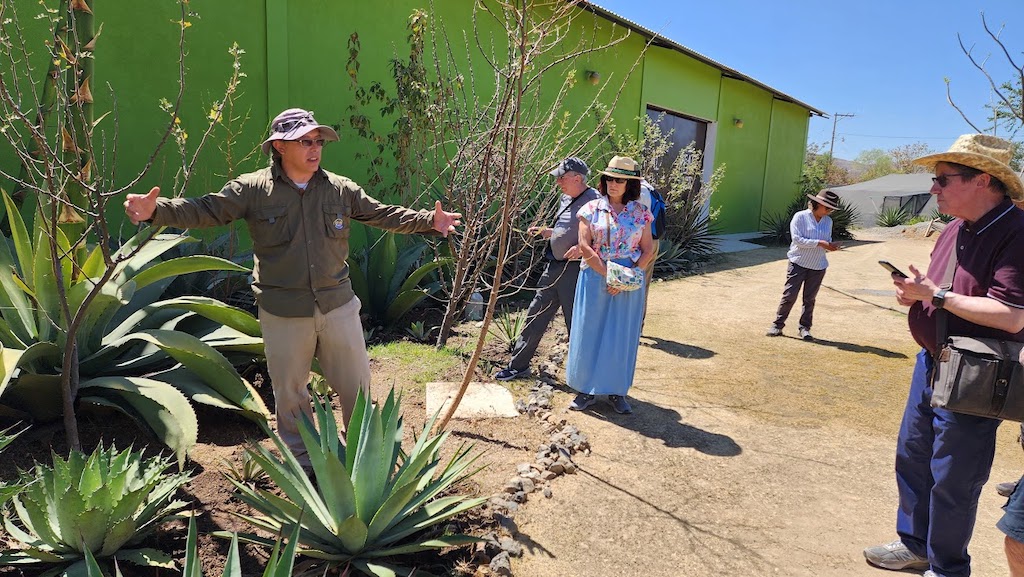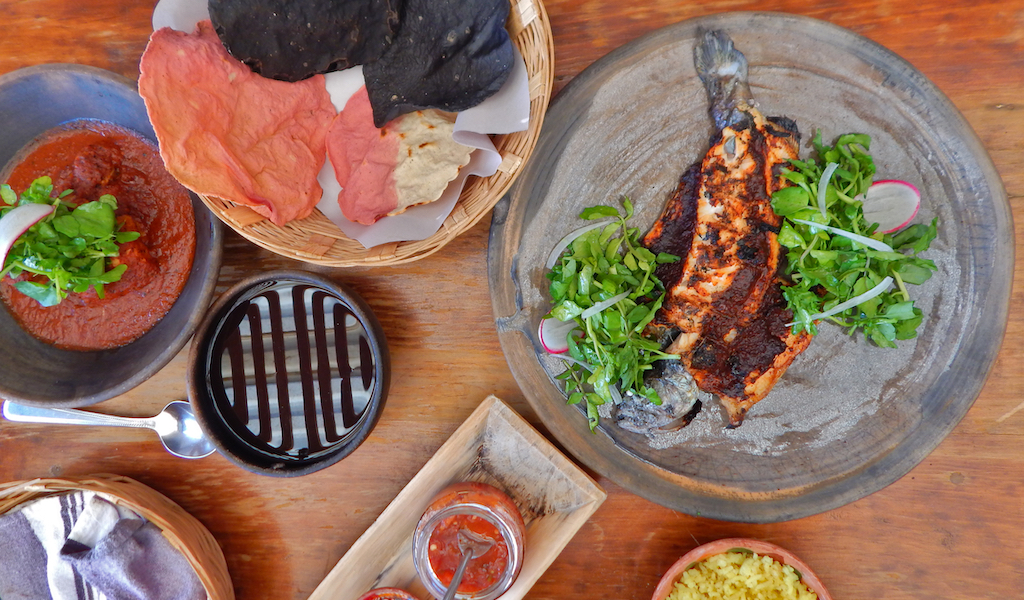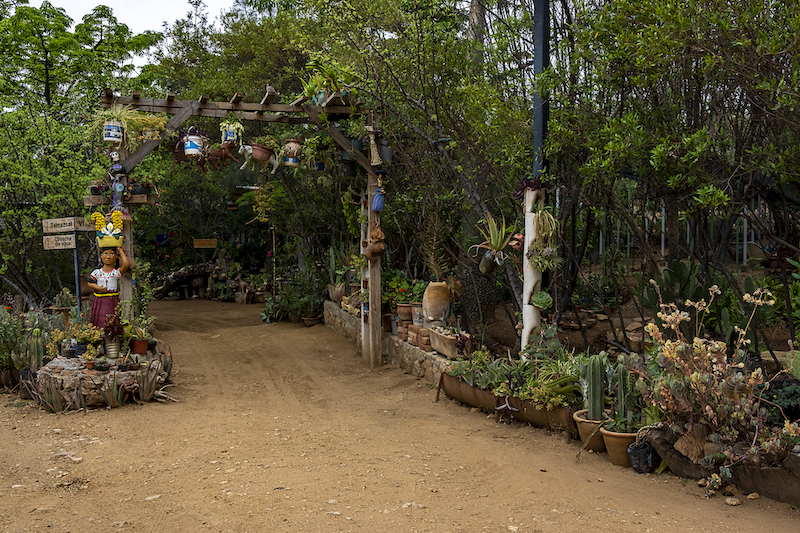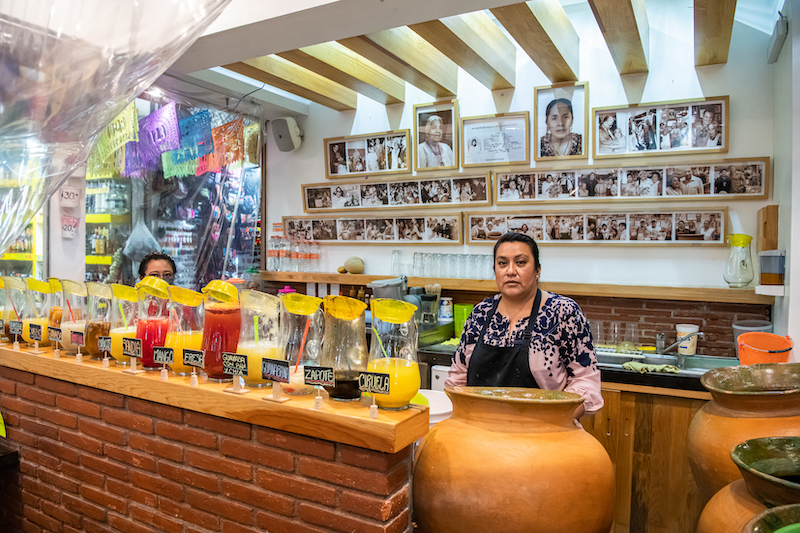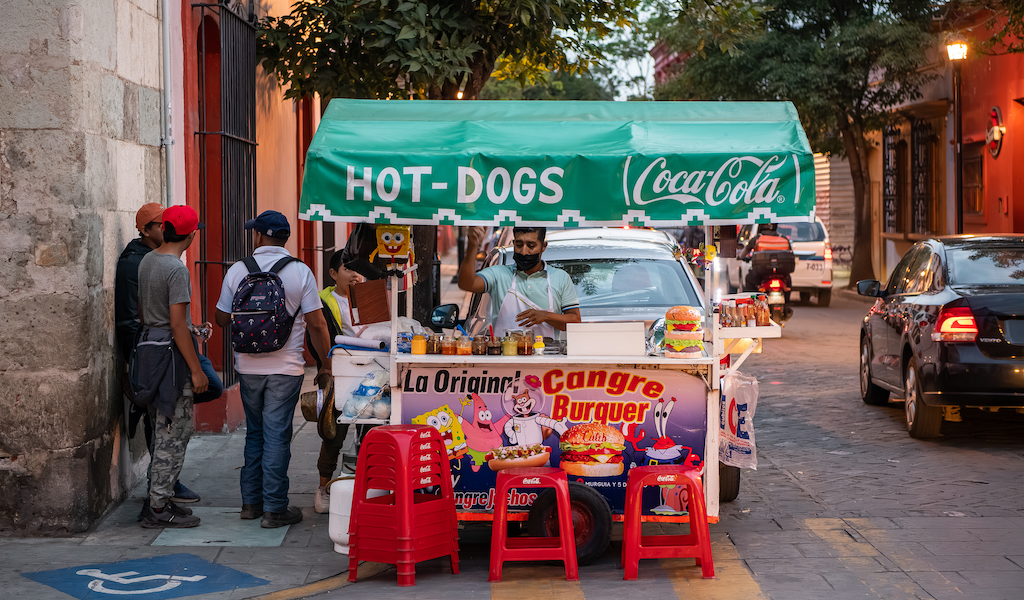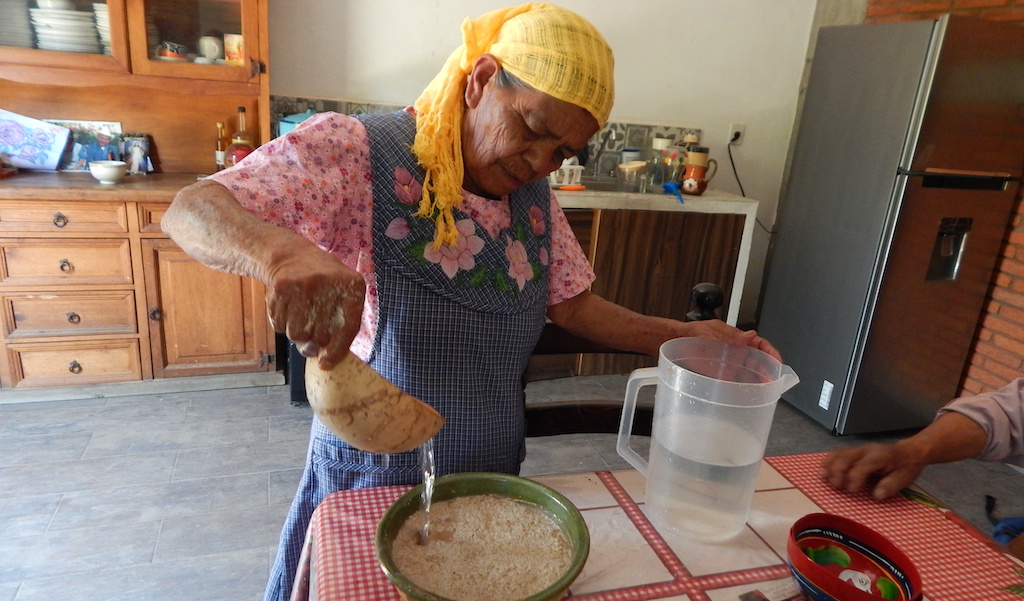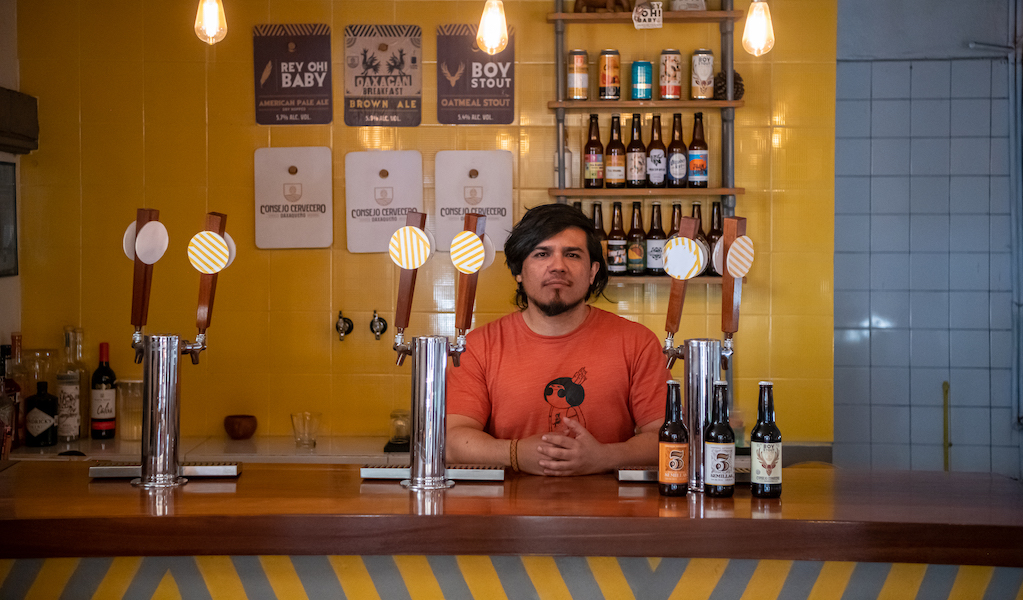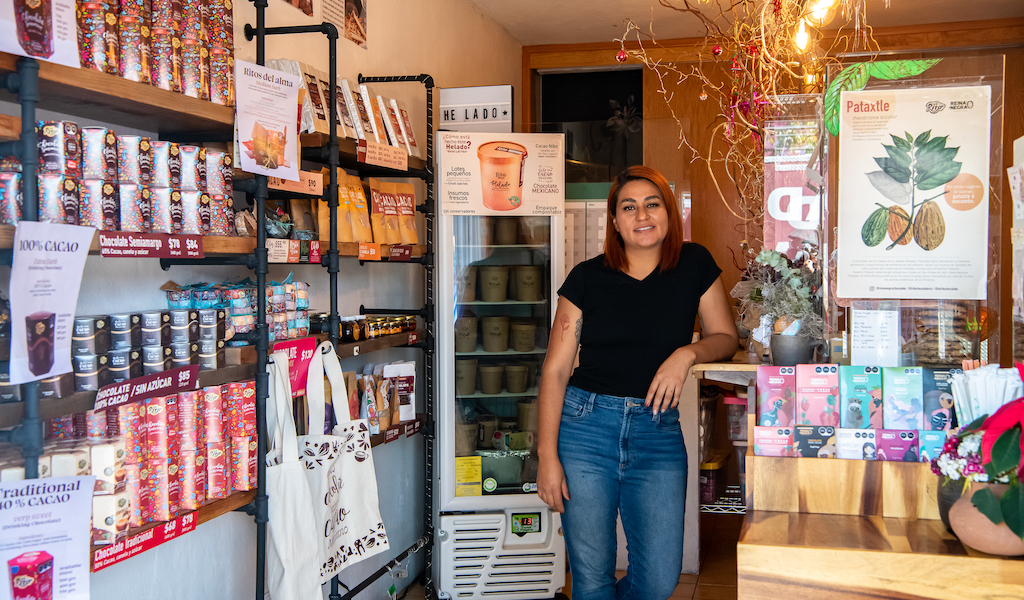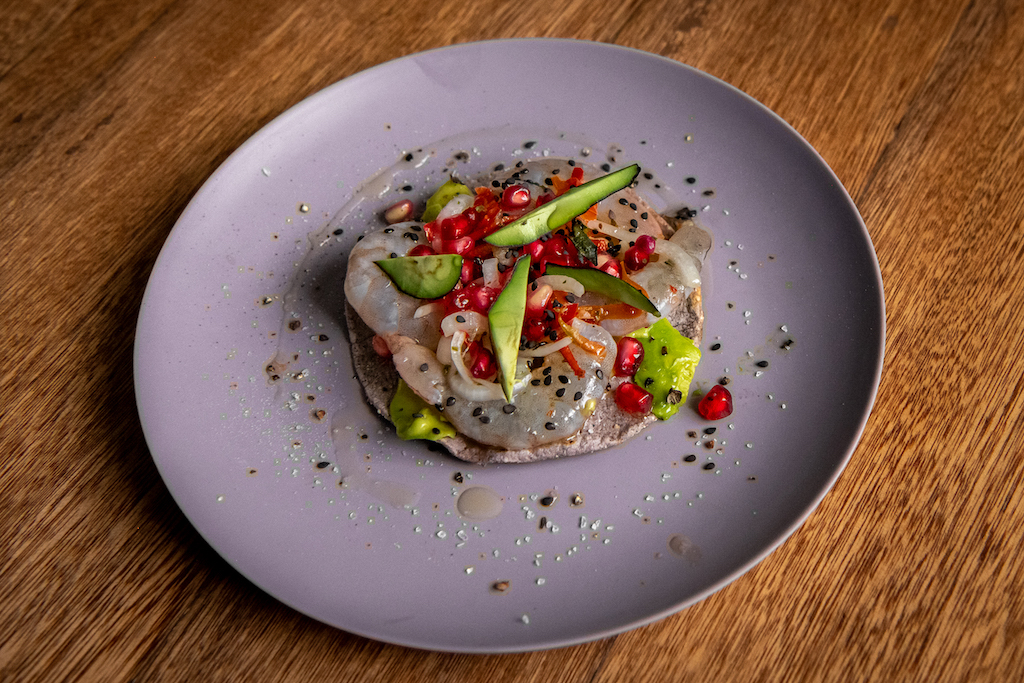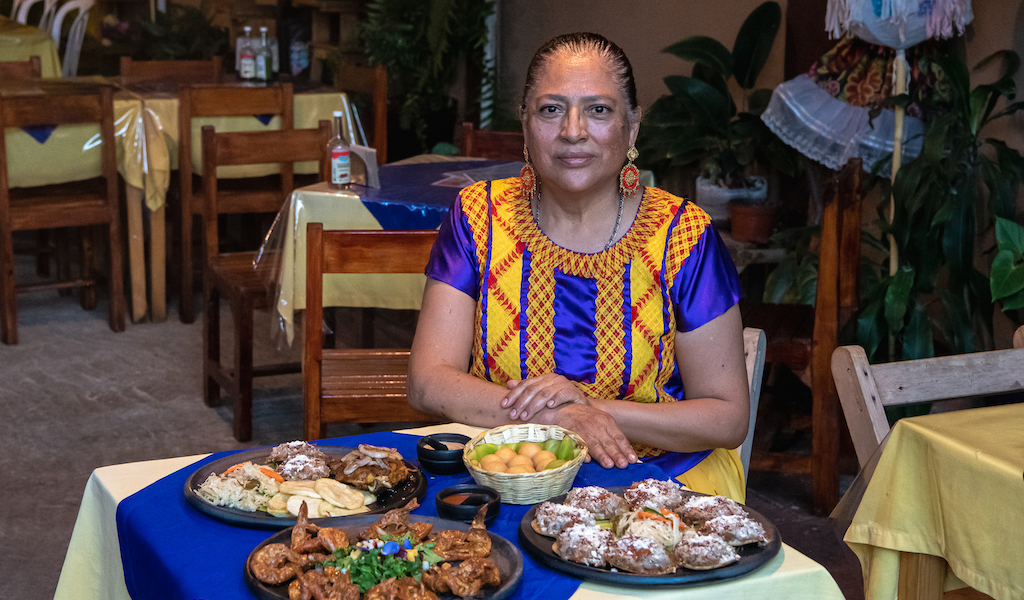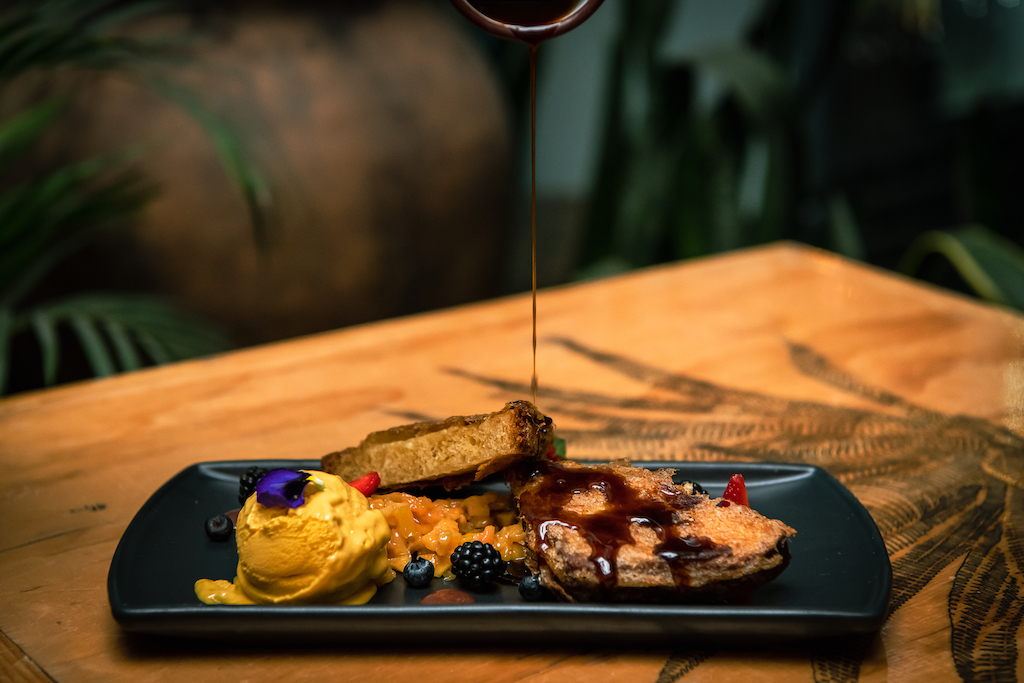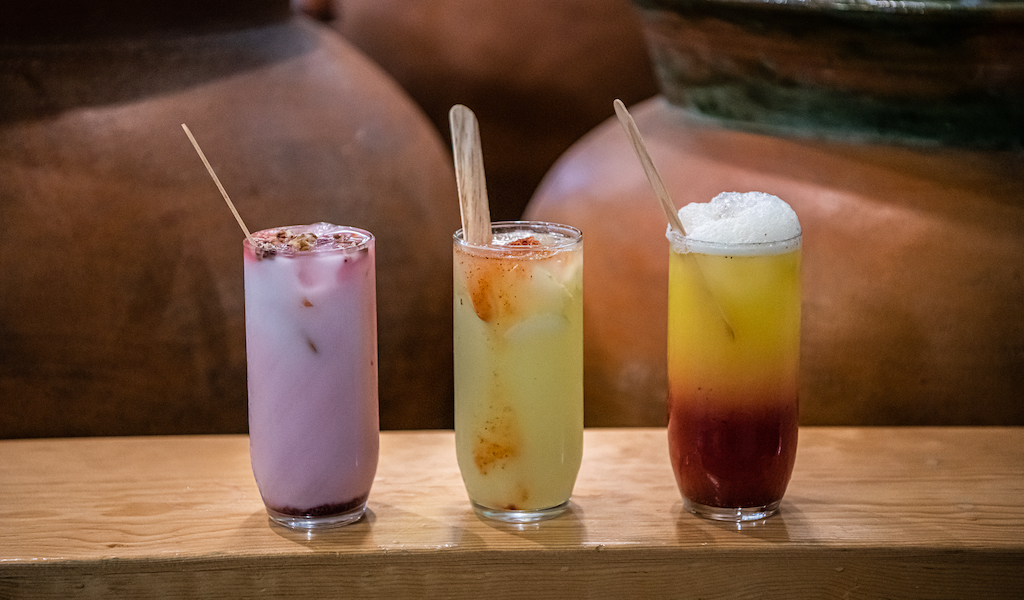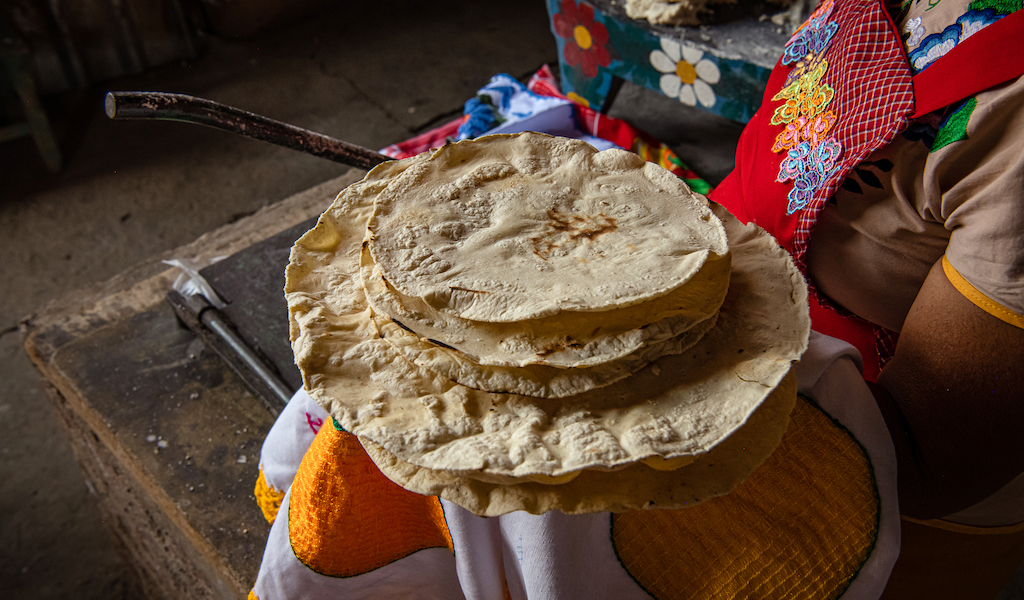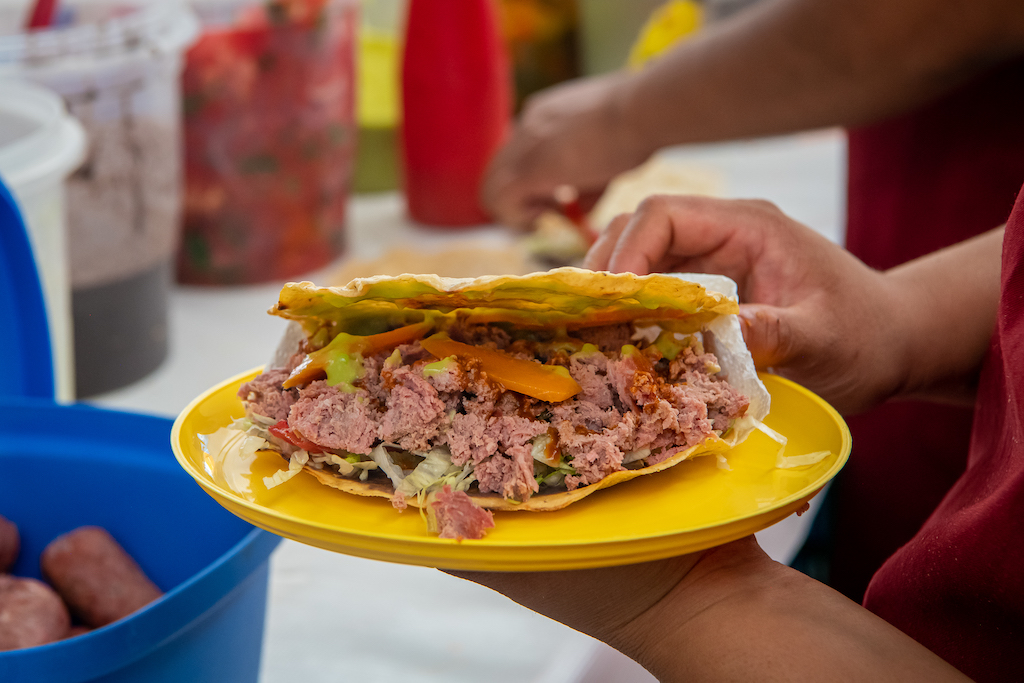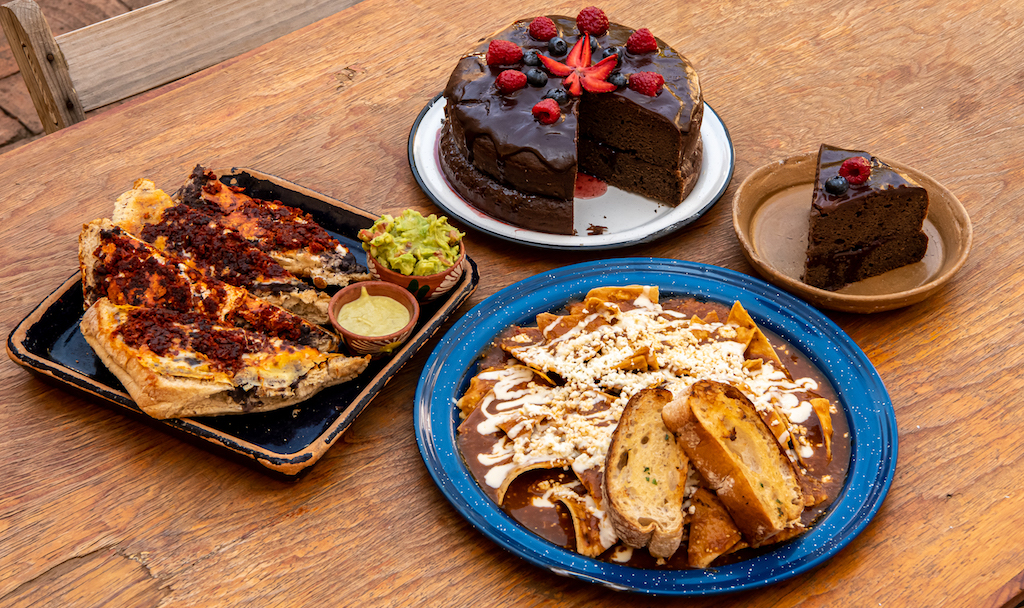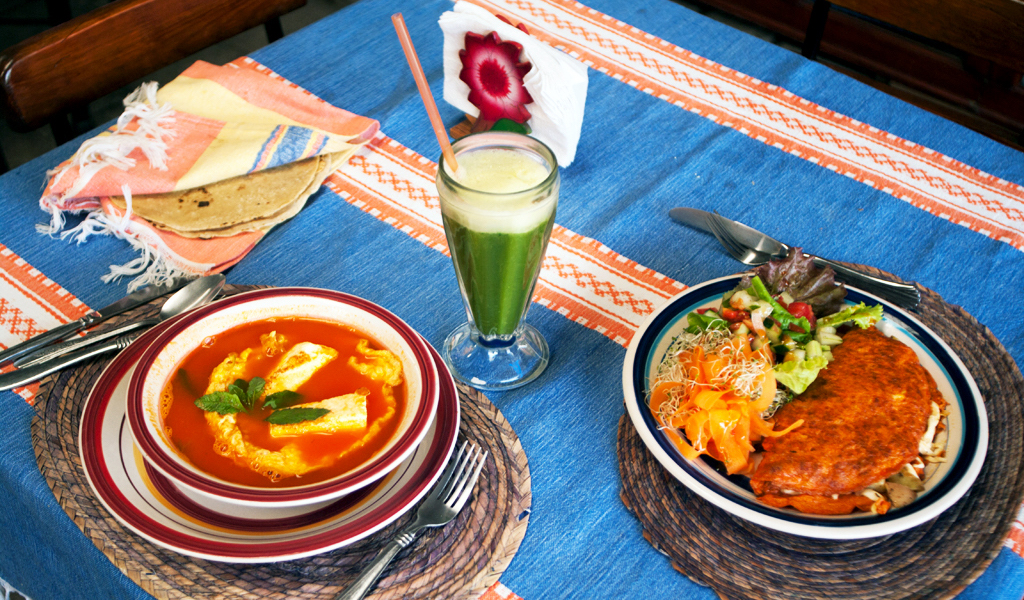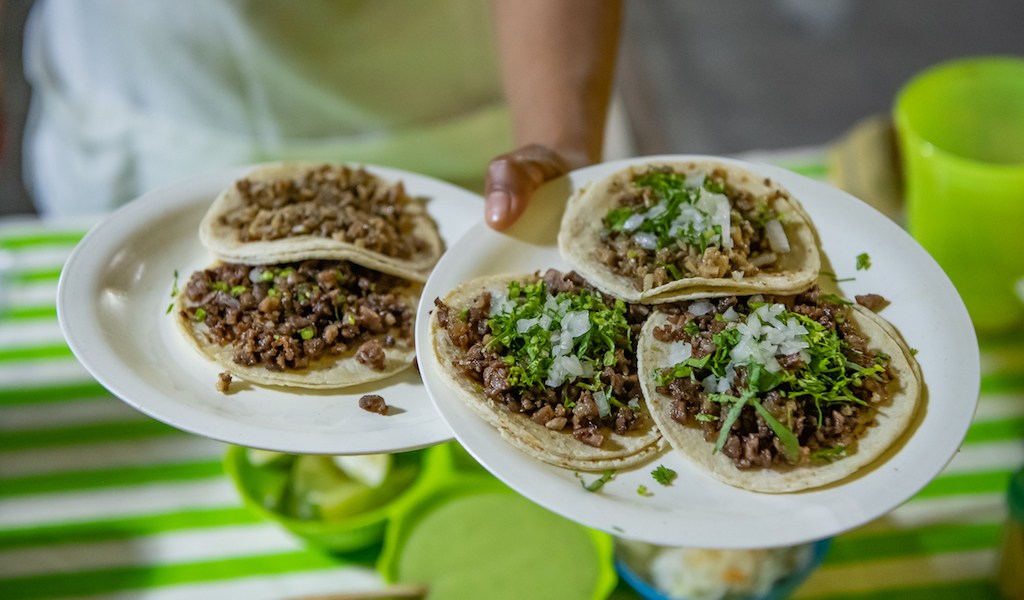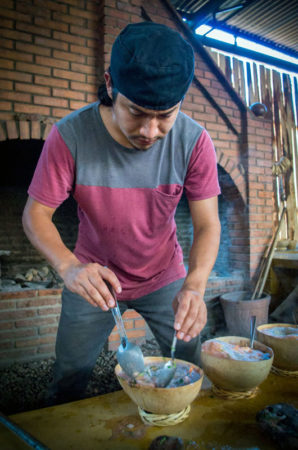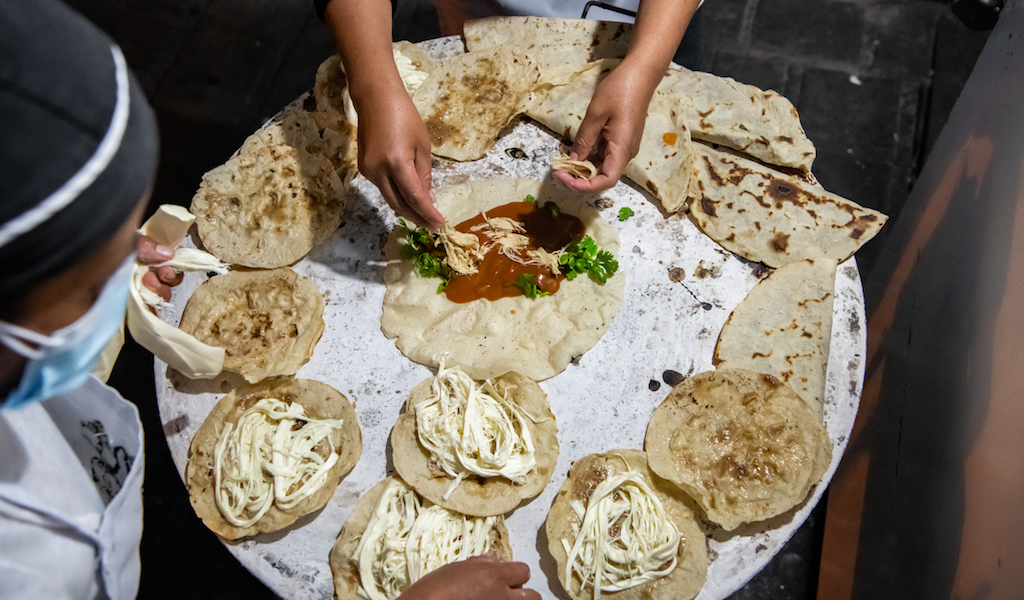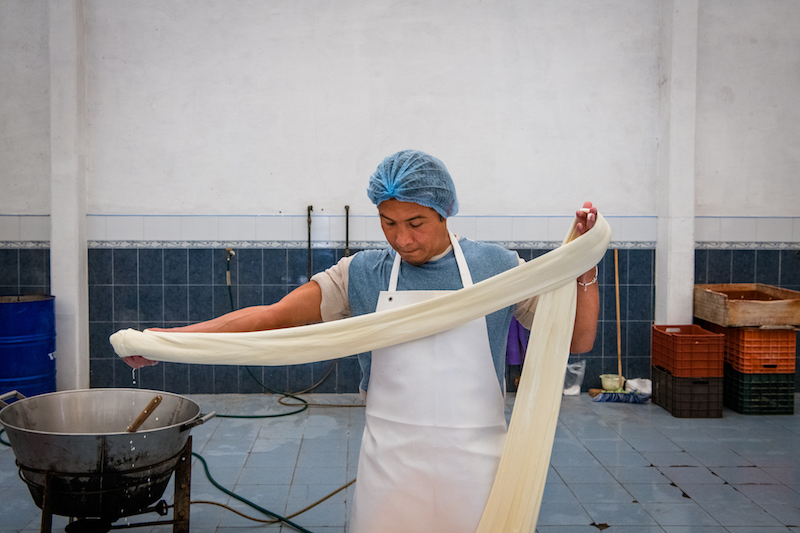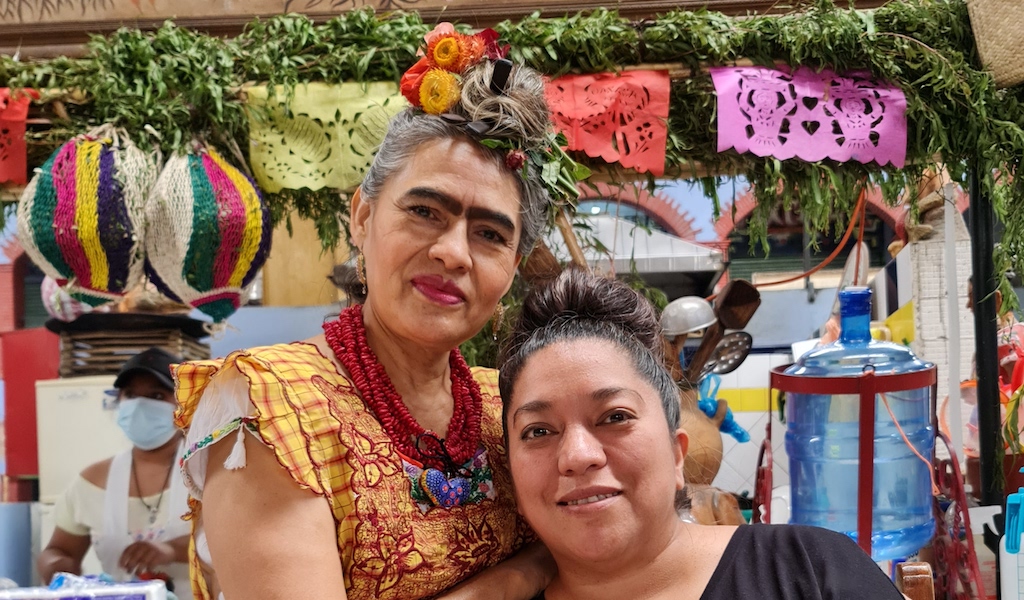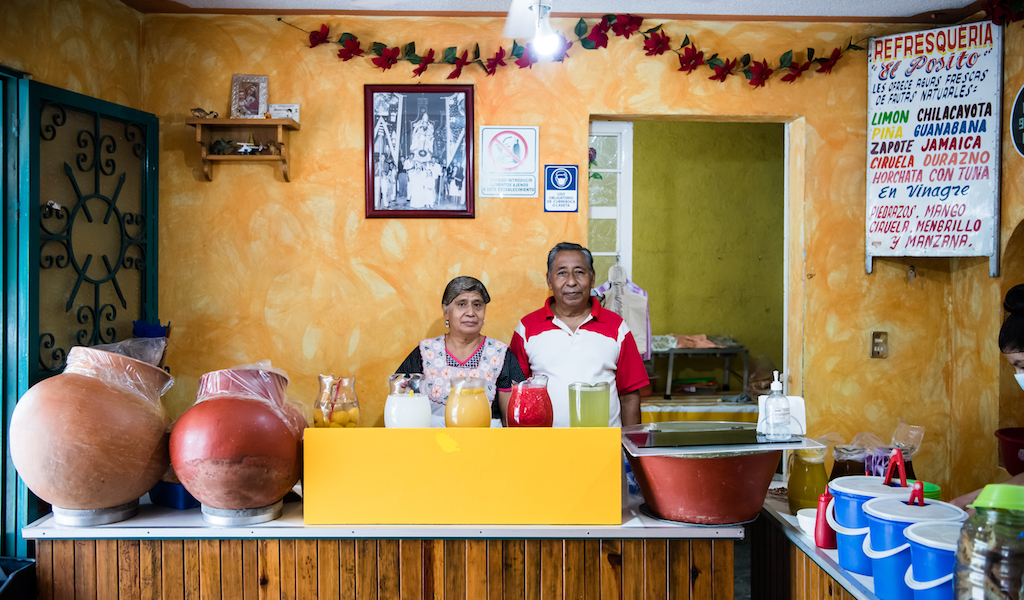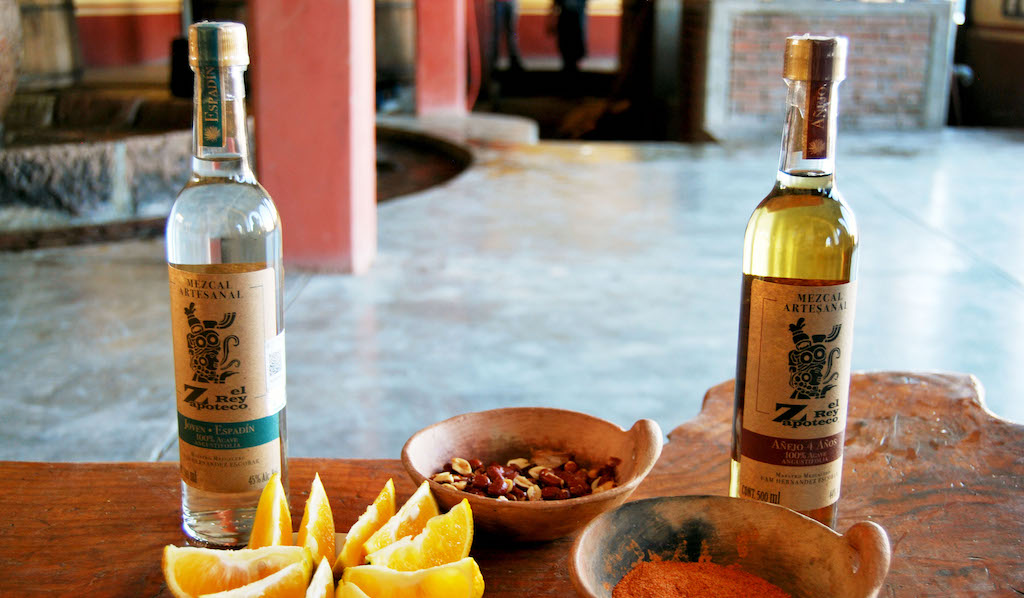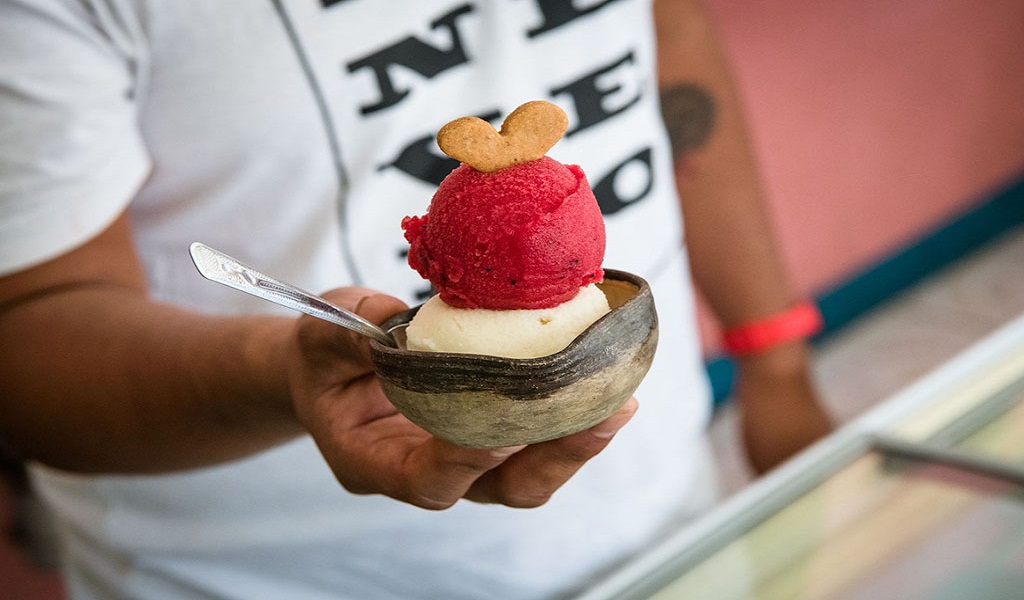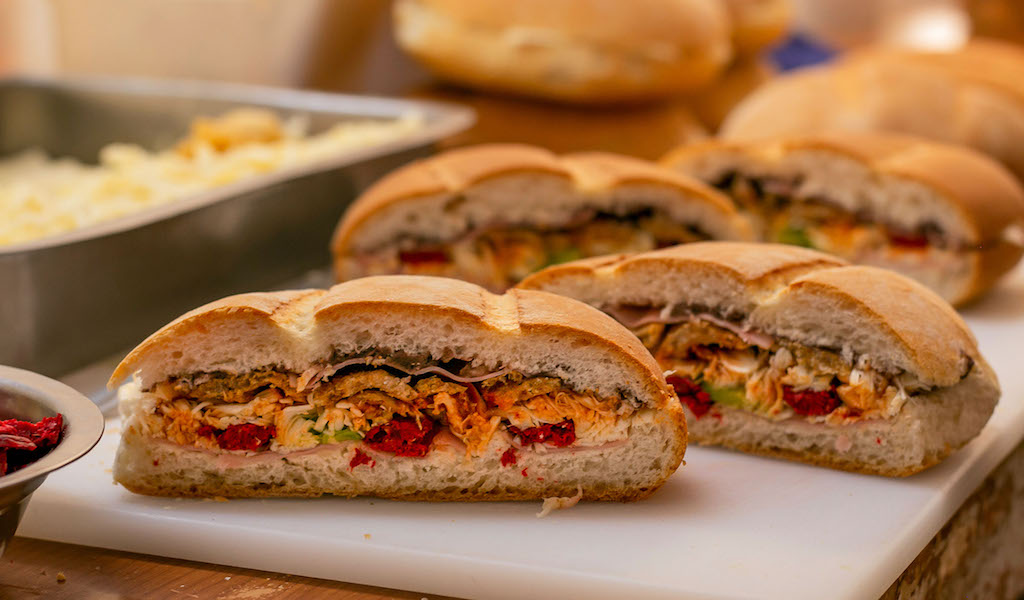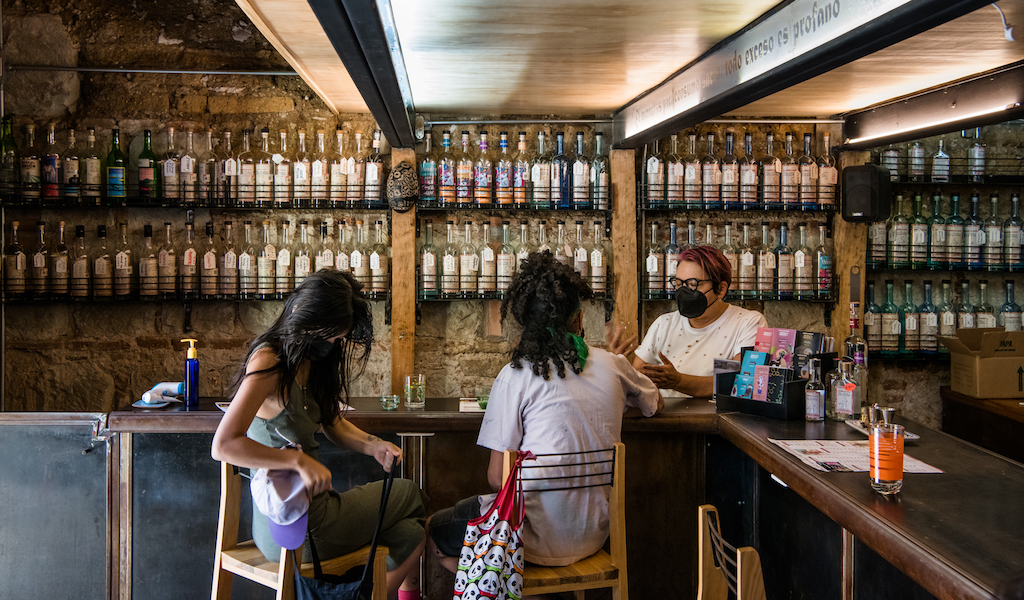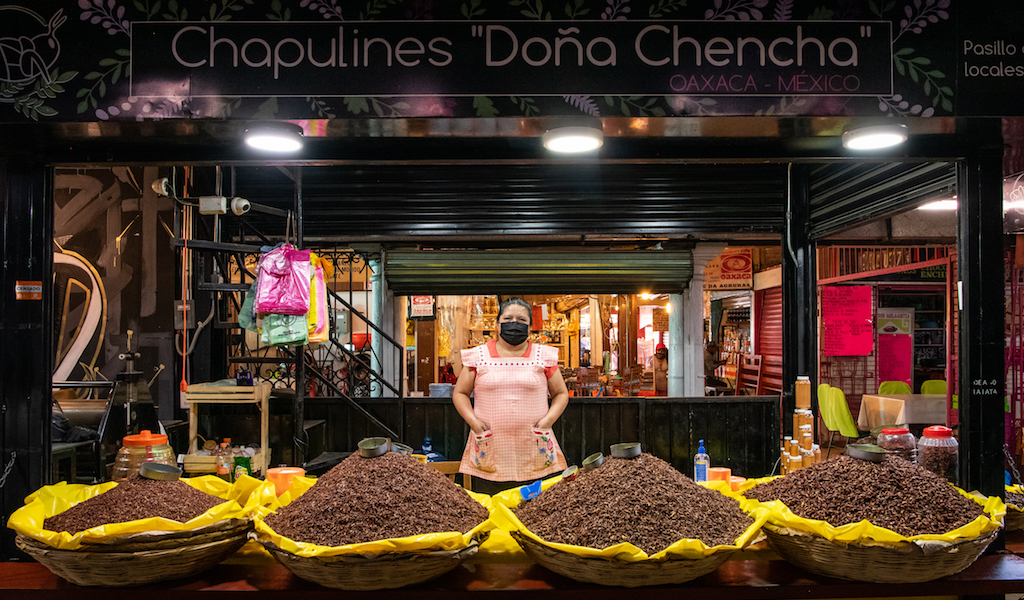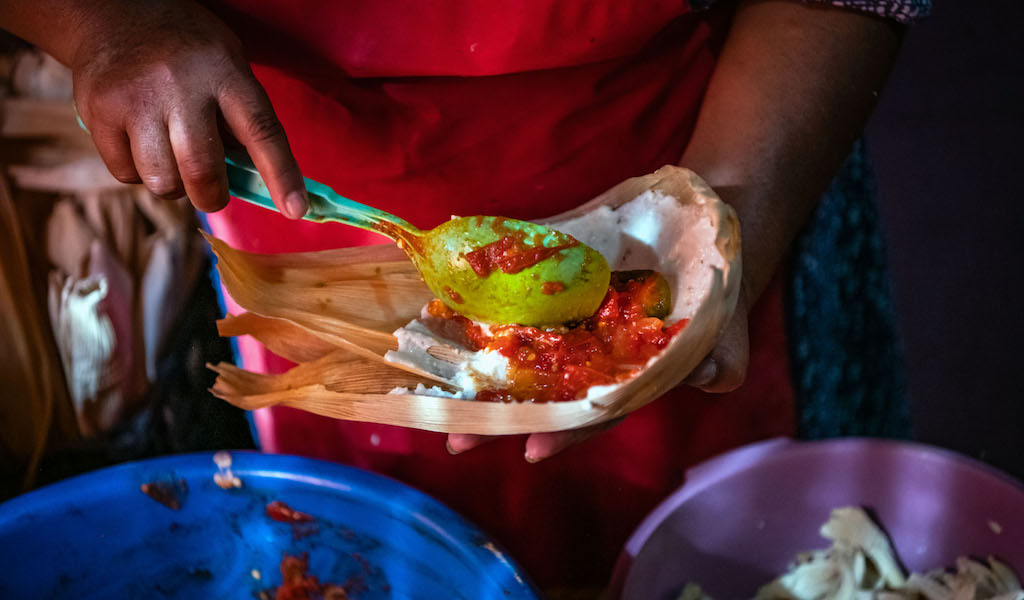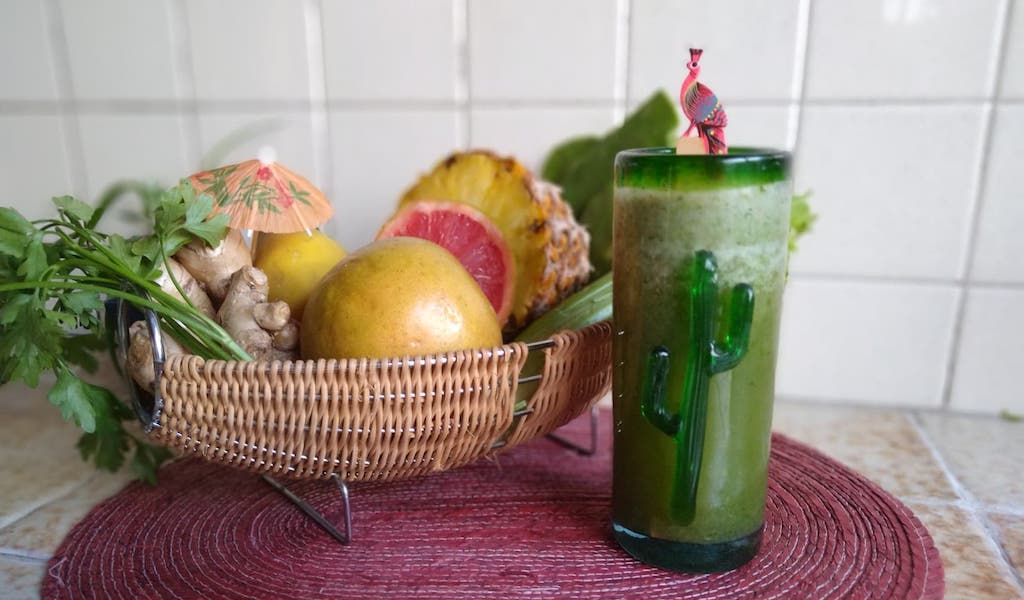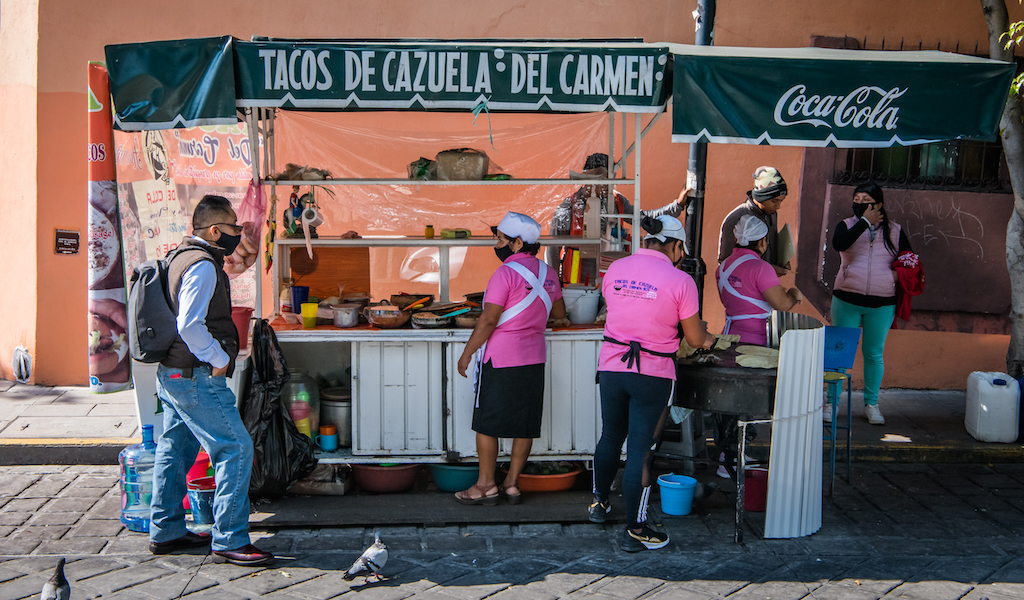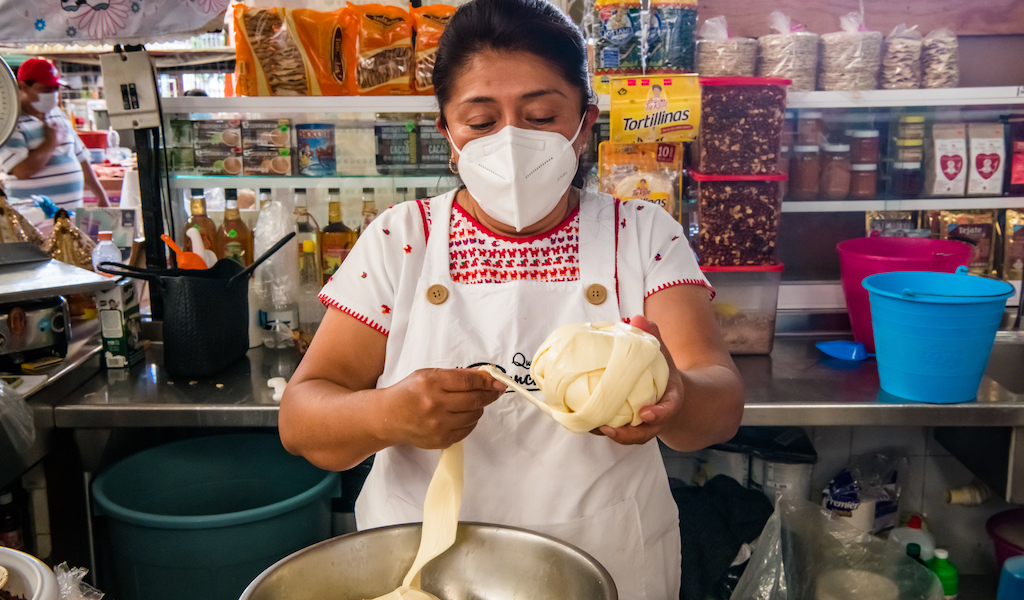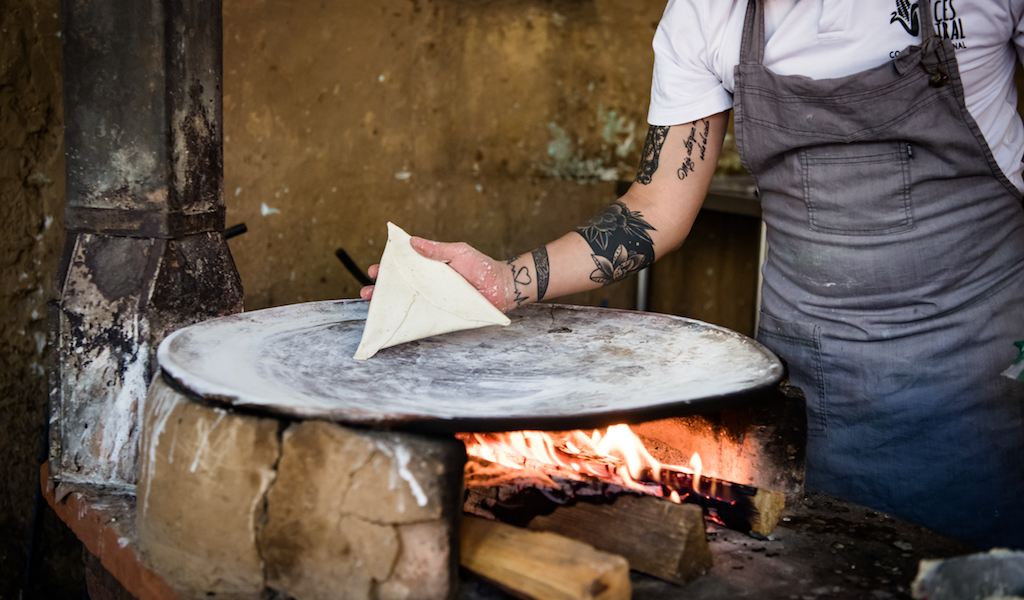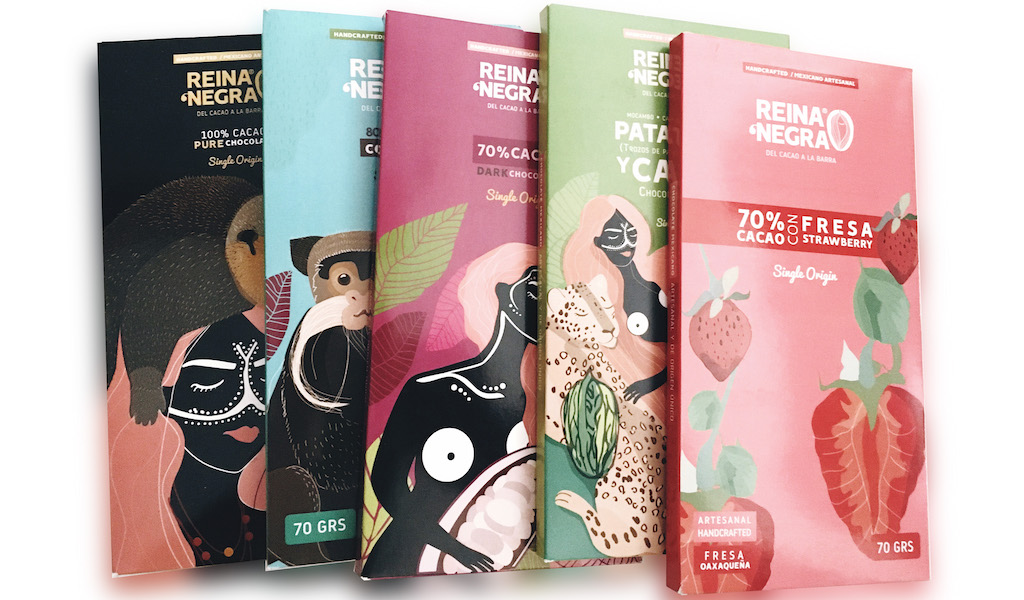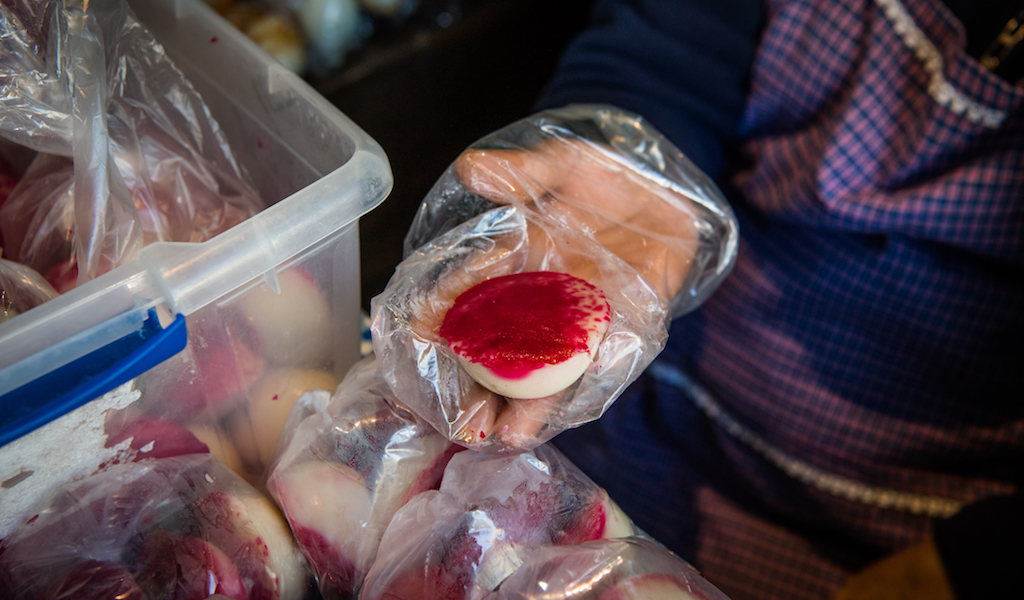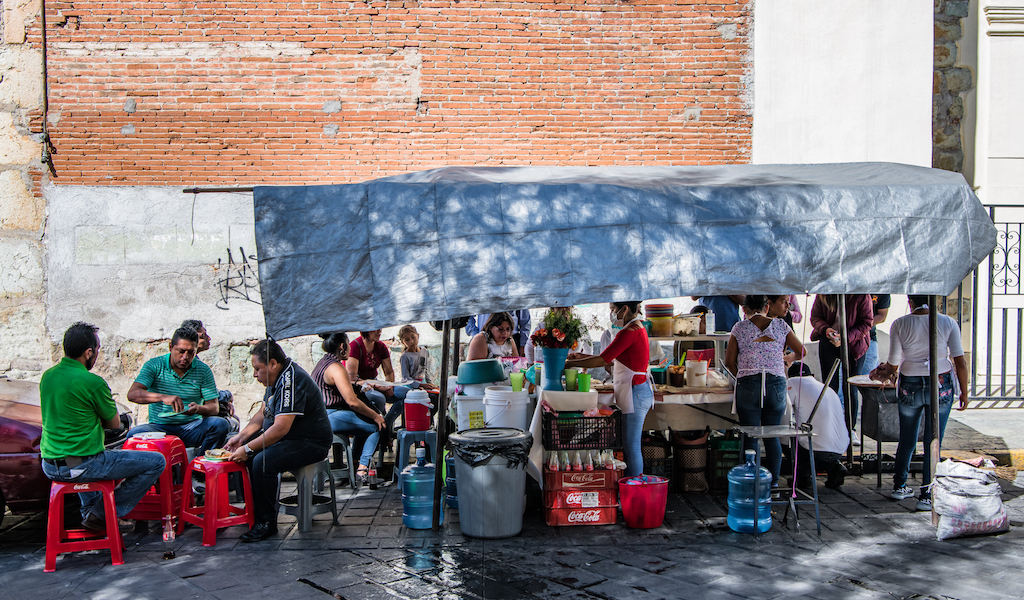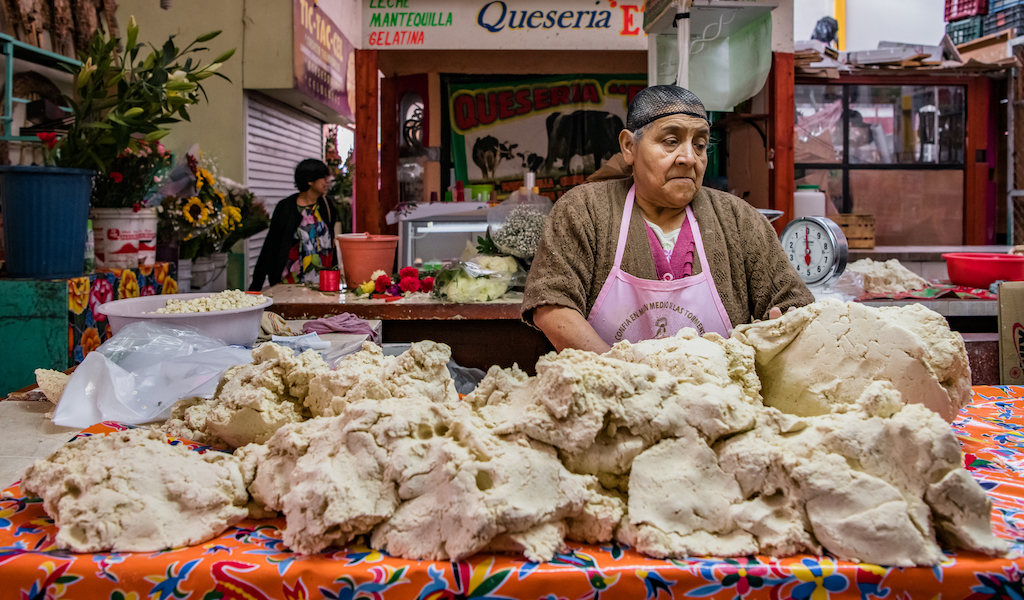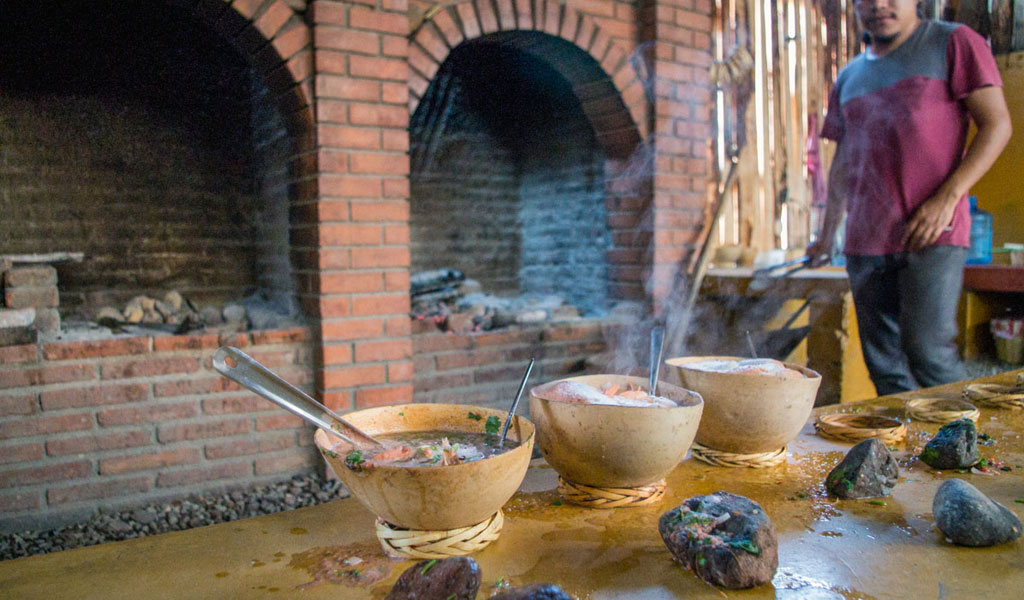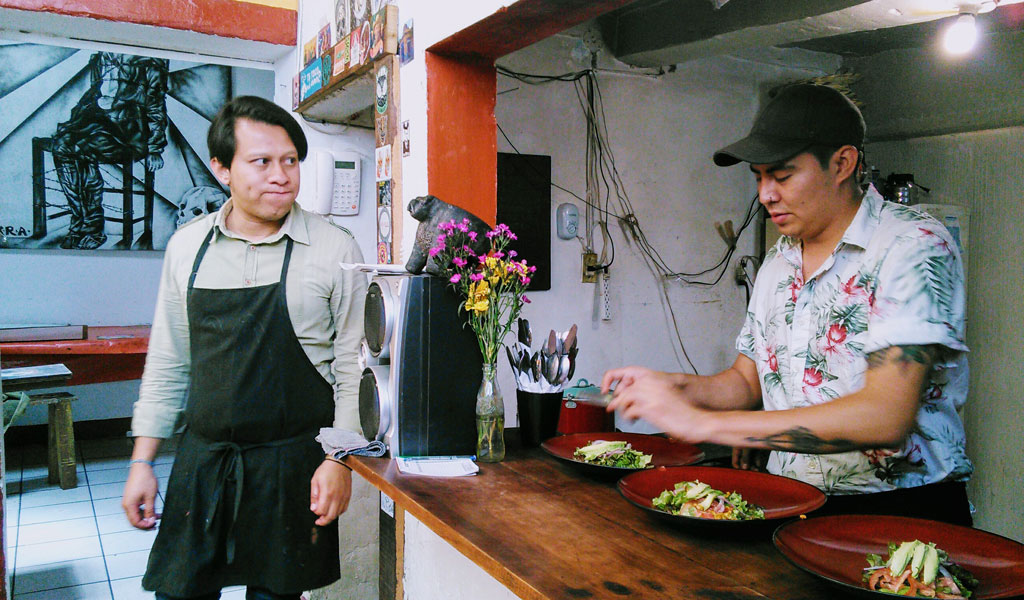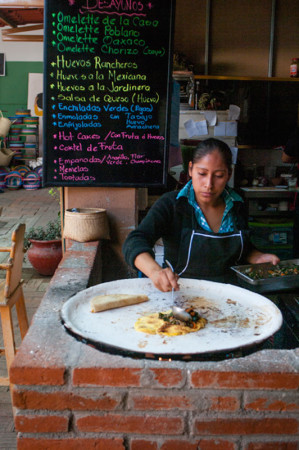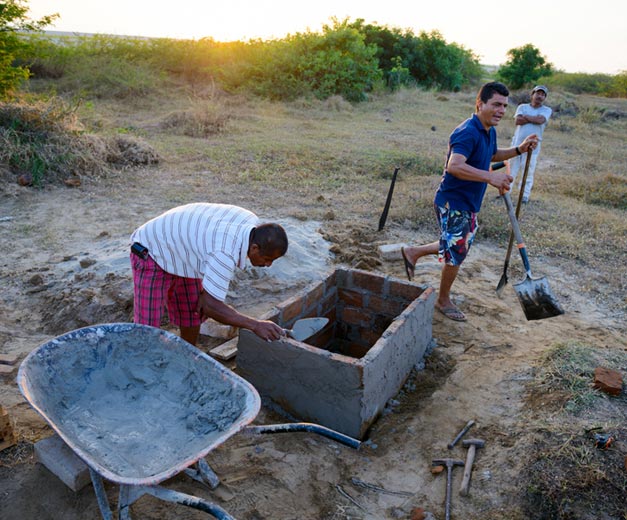We can't find the internet
Attempting to reconnect
Something went wrong!
Hang in there while we get back on track

Oaxaca
Oaxaca's culinary record
Oaxaca's deep culinary heritage is, like in many places, a result of its geography: a big valley formed by small ones, all surrounded by mountains, rich soil and warm weather. In fact, this valley reminds us of a clay pot, much like the kind used to make the area’s signature dish, mole, in which many ingredients are mixing, aging and melting together to become something new over the heat of the fire.
Get the Full Story →Tour Oaxaca with Culinary Backstreets®
Upcoming Oaxaca Food Tours
discover the city, street by street, bite by bite
Explore Oaxaca
Oaxaca
Wicho’s Donut House: Reverse Culinary Migration
As he drove us to Tlacolula, some 19 miles east of Oaxaca City, in his burgundy-and-white taxi, salsa music in the background and a tiny bronze cross hanging from his rearview mirror, our driver Félix was philosophizing about migration. Like many other Oaxacan men, he had, at one point, crossed the border from Mexico to California in search of a better life. And like many fellow countrymen, he had come back home because he refused to live a life of persecution and uncertainty due to his legal status as an undocumented immigrant. His life back in Mexico was good; hard, yes, but joyful. “I can eat fresh fruits, dance with my kids, watch them grow. If this is not quality of life, I don’t know what it is,” he reflects. The music stops and so does Félix’s taxi. In the middle of the Tlacolula highway we’ve arrived at one of the area’s largest gas stations, and our destination.
Read moreOaxaca
La Bamby: Oaxaca’s Daily Bread
La Bamby bakery sits on a strategic corner in downtown Oaxaca, between two tourist magnets, the Zócalo and the Santo Domingo church. The street corner lacks many of the vibrant elements that make this colorful colonial city a dreamy backdrop for Instagram posts; a bank stands across from it and an Oxxo, a national convenience store chain that plagues most Mexican cities, sits next to it. Like its neighbors, La Bamby is highly functional, serving one very practical purpose: supplying the city with fresh, affordable bread. With over 50 years of history, the bakery is an institution in Oaxaca.
Read moreOaxaca
The Essentials: Where We Eat in Oaxaca, Mexico
Oaxaca’s deep culinary heritage is, like in many places, a result of its geography: a big valley formed by small ones, all surrounded by mountains, rich soil and warm weather. In fact, this valley reminds us of a clay pot, where many ingredients are mixing, aging and melting together to become something new over the heat of the fire. Oaxaca’s best restaurants are firmly rooted in this unique geography and layered history of the state. Here, food is more than just sustenance; it's a living link to the past and an expression of community – and it’s a source of immense pride. From the foundational significance of corn, prepared in countless forms, to the complexity of its celebrated moles, Oaxaca is all about depth. To highlight this profound connection between land, culture, and cuisine, our local team has rounded up their essential spots in the city, for tlayudas, memelas, mole, and beyond.
Read moreOaxaca
El Tendajón Agavería: Something For Everyone
In Oaxaca, when friends come together to eat after a long night out, sitting down for brunch becomes a challenge – everyone has different cravings and dietary needs. In the heart of the city center, there is a place with something for everyone: Tendajón Agavería The all-day eatery is a true standout among the numerous restaurants that serve classic Oaxacan food, offering a variety of dishes that oscillate between traditional and innovative flavors. From the Croque Madame with smoked quesillo to a fresh poleo mint couscous with shrimp cooked in chintextle (chili paste), the menu has a strong Oaxacan overtone interpreted in very unexpected ways.
Read moreOaxaca
Salchicha Ejuteca: The Real Oaxacan Sausage
The history of Oaxacan food is deeply linked to the concept of adaptation. Our culinary identity has many chapters: the Mesoamerican native period, the colonial reign of Nueva España and the Mexico of the 20th century, which received another wave of immigrants who brought their gastronomic traditions and let them combine with the native and more tropical ingredients of these altitudes. That is the story of the salchicha ejuteca, a European style beef sausage that unexpectedly became one of the most desired foods on the Oaxacan snack table. While traditional corn-based products are a signature of Oaxacan cuisine, the salchicha ejuteca is an underestimated traditional element in the state’s food landscape. “Nobody knows for sure where the salchicha comes from.
Read moreOaxaca
Best Bites 2024: Oaxaca
Throughout this year, food has been a shelter and a source of comfort and healing. From tacos that put us at ease with their tender meats and flavorful salsas, to drinks that cooled us down and helped us sharpen our weary minds, the following are the bites that, for us, were some of the best in town in 2024. - María Ítaka A little space that feels familiar despite its very recent opening, La Frijolería specializes in all things beans, which are one of the ultimate comfort foods in our cuisine. Ironically, before La Frijolería opened its doors, it was hard to find a restaurant in town where beans were served as anything other than a side dish. But now our cravings can rest assured that they will be fulfilled.
Read moreOaxaca
Garnachas La Güera: Food from Tropical Oaxaca
At the bottom of a quiet street in Colonia Reforma, a neighborhood located in the northern-central area of Oaxaca City which hides many of the city’s best-kept food secrets, we find Garnachas La Güera. While the area is characterized by its quiet, residential streets, this restaurant is a small paradise where joy, music and good food transport you to the tropics. Garnachas La Güera specializes in food from Juchitán, a village in the Isthmus of Tehuantepec, close to Oaxaca’s southeastern coast and the border with the neighboring state of Chiapas. If Oaxaca is a state, Juchitán is like its own country within it.
Read moreOaxaca
Sopa de Guías: Oaxaca’s Rainy Season Soup
In early fall, Oaxaca’s landscapes are a study in green. Walking through the city’s colonial center, tall trees’ crowns explode in verdant glory, while vistas in the countryside are even more impressive, boasting an array of variegated grasses, deeply colored agaves, and, of course, stalk upon stalk of corn, heavy with plenty of ears of the country’s most prized aliment. It’s the end of the rainy season here in this southwestern state, the humid period that typically runs from June until October. And after a disappointingly dry season last year, farmers and home growers across the region are celebrating the success of their milpa, the ancient, complementary agricultural system of corn, beans, squashes, and wild and domesticated greens growing all together in interdependent and symbiotic harmony.
Read moreOaxaca
Late-Night Bites: Oaxacan Food After Dark
Oaxaca’s urban identity has been shaped in part through food and eating habits, a phenomenon that is perhaps best experienced as the sun starts to set. At dusk, food stalls start to open, filling the streets with the aroma of dishes that are now staples of Oaxaca’s vibrant food scene. These sweet and savory treats have been developed over decades – if not centuries – to become integral parts of what we now recognize as Oaxacan cuisine. Each dish and ingredient here tells a long story, deeply connected to the place where it’s offered and the time of day it’s consumed. From the tortas and tostadas serving the hungry after-work crowd to lime-and-chile seasoned elote and esquites (corn on the cob or in a cup – the perfect mobile snack to enjoy in the park) to late-night tlayudas or a smoky mezcal nightcap, the Oaxacan night is for savoring.
Read moreOaxaca
La Original Cangreburger: Fast Food Artistry
It is 6:30 pm – the workday of most of the taco, quesadilla and memela vendors in the city is over, but “The Artist’s” shift has just begun. Every day, as the dusk light bathes the streets, 34-year-old Caleb Santiago sets up his food cart right below the centuries-old clock that overlooks the corner of 5 de Mayo and Murguía. By 7:00 pm, he is ready for another night of juicy hamburgers and hot dogs. Among all the late-night hamburger stalls sprawled across the city, Caleb’s is something else. Initially known as just “Cangreburgers,” this little SpongeBob Squarepants-inspired cart has been feeding Oaxacans for the last 16 years.
Read moreOaxaca
Empanadas del Carmen Alto: Oaxacan Fundamentals
Oaxaca’s street food scene has surprises for us every day of the week. From breakfast to lunch, we can find plenty of stalls with a plethora of options: eggs, tamales, tortas, tacos, hot drinks, juices and more. However, when sunset bathes the streets of the historic center, most of these stalls are disassembled into heaps of tarps, letting esquites, burger and hot dog stands take over the night shift. Fortunately, this is not the case for Empanadas del Carmen Alto, a classic among locals for serving up daytime dishes until midnight. The menu at Empanadas del Carmen Alto is succinct: memelas (thick corn tortillas topped with various ingredients), the famous empanadas de amarillo (calzone-like corn tortillas filled with chicken and mole amarillo) and squash blossom or mushroom quesadillas.
Read moreOaxaca
Dulces Oaxaqueños: Rescuing Endangered Sweets
In Oaxaca, social matters are reflected in our foodways: there are certain flavors for times of sharing and growing, others in times of mourning, and many more when it’s time to support and celebrate. Some of our earliest lessons come through the honeyed flavors of dulces regionales – “regional sweets.” These represent an interesting range of treats that look as if they were taken from a 100-year-old recipe book – which they are. Nevertheless, in a world of colorful cakes and extravagant cupcakes, these complex traditional sweets risk being lost forever. Once upon a time not long ago, colorful displays of stalls selling dulces regionales adorned almost every corner and plaza in the Historic Center, but nowadays, at least in the city, the former glory of these treats has started to fade. The current sources for Oaxacan regional sweets is down to just a few makers taking private orders, a couple of stalls in the Benito Juarez market, and a dozen street vendors in the city’s most touristic areas.
Read moreOaxaca
Las Chiquihuitas: Organic Collective Action
Las Chiquihuitas is a relative newcomer to Oaxaca’s organics scene that celebrates its two-year anniversary this month. A tiny sliver of a corner store located right smack-dab in the city’s historic center, the shop manages to pack a surprising amount of organic, local and lovingly produced foods within the diminutive confines of its four walls. A quick examination of Chiquihuitas’ lone refrigerator turns up a candy-colored array of seasonally flavored kombuchas and ginger beers stacked above a selection of buffalo milk butter and cheeses sourced from the Oaxacan coast, plus chunky glass jars of ferments ranging from classic sauerkraut to spicy kimchi. The store’s selection of dry goods might include shiny black beans, sticky, dark-brown blocks of the unprocessed sugar known as panela and jugs of fragrant virgin coconut oil. Happily, there’s a robust lineup of fresh produce, too, with juicy tomatoes, spiky pineapples and nubby potatoes peeking out of the black plastic crates dominating one of the store’s shelving units.
Read moreOaxaca
Wicho’s Donut House: Reverse Culinary Migration
As he drove us to Tlacolula, some 19 miles east of Oaxaca City, in his burgundy-and-white taxi, salsa music in the background and a tiny bronze cross hanging from his rearview mirror, our driver Félix was philosophizing about migration. Like many other Oaxacan men, he had, at one point, crossed the border from Mexico to California in search of a better life. And like many fellow countrymen, he had come back home because he refused to live a life of persecution and uncertainty due to his legal status as an undocumented immigrant. His life back in Mexico was good; hard, yes, but joyful. “I can eat fresh fruits, dance with my kids, watch them grow. If this is not quality of life, I don’t know what it is,” he reflects. The music stops and so does Félix’s taxi. In the middle of the Tlacolula highway we’ve arrived at one of the area’s largest gas stations, and our destination.
Read moreOaxaca
Oscuro Brebaje: Potent Potions
As difficult as the last two years have been for food businesses, it has offered many establishments an opportunity to rethink how they do things and come back with a greater sense of purpose. Take the example of Oaxaca’s Oscuro Brebaje, a café that took a pause, only to emerge stronger and more inviting. Founded in 2015 by a young barista, Andrés González Martell, Oscuro Brebaje started off serving artsy frappés, light breakfasts and unforgettable cakes – all of which have become the signature bites of this unassuming café located in the old neighborhood of La Noria. Here, locals and visitors interact in the peaceful and picturesque streets full of old houses and colorful facades.
Read moreOaxaca
Building Blocks: Tortillas, A Culture’s DNA
Every time we travel outside of Oaxaca, we get something we call “the tortilla blues.” Even if we move around inside of Mexico, particularly in the biggest cities, we cannot help missing the sweet aroma and feel of a warm tortilla almost melting in our hands. Sure, we might run into decadent tacos filled with perfectly cooked meat, or we can taste amazing enchiladas with lush salsa verde. But none of that matters if the tortillas don’t seem to have been touched by the tortillera’s (tortilla maker’s) gifted hands. Everyone talks about the tortilla but not everyone understands it. Supermarkets sell them packed and ready to heat, office workers eat them carelessly at their desks for lunch and only fancy restaurants seem to offer a more authentic version of them.
Read moreOaxaca
Tamales de Tia Tila: Steamed Comfort
It’s a cold December afternoon when we arrive at the headquarters of Tamales de Tia Tila in San Gabriel Etla, about 45 minutes outside of Oaxaca City. Knocking on the door, we catch a whiff of spices and corn that the cold wind quickly steals away. But as soon the door swings open, revealing a family with faces half-covered in masks and hands busy at work, waves of warm, fragrant air envelope us. The tamal workshop is brimming: a man is moving stews, a woman pressing dough, an older woman laying corn husks and banana leaves on one of the many tables. Everyone’s movements are so precise and focused that we feel guilty for intruding. But that feeling fades away when a young girl waves us in and brings over a cup of hot coffee.
Read moreOaxaca
Best Bites 2023: Oaxaca
Culinarily speaking, 2023 was irreverent and loud. It tasted like salty melted cheese, fried beef, hot sauces, sour lime-flavored water, tropical fruits, and beer – lots of hoppy beer. While Oaxaca’s top restaurants kept it classy and stylish, the groovy craft beer bars, as well as the buzzing market and street food stalls told a frantic story of crowded seats, euphoric clients and scrumptious food and drinks. This year’s Best Bites include recipes, dishes or drinks that proved to us there are no limits or assigned spaces for gastronomic evolution. In the realm of food, true culinary art knows no distinction and no matter where they come from, flavors will be flavors.
Read moreOaxaca
Pan con Madre: Oaxaca’s Sourdough Pioneer
Six days a week, Pan con Madre buzzes with activity, filled with the irresistible scents of rows and rows of freshly baked sourdough bread and other treats. While today this is one of Oaxaca’s most interesting and popular bakeries, the road to success for Pan con Madre has been a long journey of experimentation, risk taking and innovation. In 2015, a very inspired Jorge Rodrigo Ocampo, now 38, arrived in Oaxaca City with the idea to open a space where he could put all his bread-baking knowledge into action. During his university years he had complemented his biology studies with a part-time job as photojournalist for newspapers in Guadalajara, Querétaro, and his hometown of León, but it was baking that truly captured his imagination.
Read moreOaxaca
A&V La Casa del Pulque: Saving a Tradition, At the Source
Driving east from Oaxaca City, Mexico, into Santiago Matatlán – the town of about ten thousand souls that’s known as the “World Capital of Mezcal” – one’s vista is suddenly dominated by the color green. Across the landscape of gently rolling hills, enormous patchworks of planted agave fields supply the eye with an entire spectrum of verdure, from sage to emerald to jade. The large, spiky magueys, as they’re also called, are everywhere you look, their dusty shades contrasting with the brighter green of the grasses and cacti also dotting the region’s slopes. But we’re not here for mezcal. Instead, different agave beverages are on the menu today: fresh aguamiel and lightly fermented pulque, harvested daily on this land by fifth-generation owner Reina Luisa Cortés Cortés of A&V La Casa del Pulque.
Read moreOaxaca
Obispo Cocina Rural: Triangles of Happiness
Throughout Mexico, both foods and drinks are centered around corn, a tendency that’s most evident in Mexico’s wide variety of antojitos, or “little cravings,” small, portable snacks featuring some variation on the corn tortilla – of which the taco is undoubtedly the most well-known globally – antojitos are one of the joys of Mexican cuisine, and vary impressively across the country’s 32 states. In the southwestern state of Oaxaca, there’s no shortage of delicious antojitos – at breakfast, soft, steaming tamales wrapped in the region’s abundant banana leaves are the name of the game, while night owls have ample opportunity to crunch into a tlayuda, a giant tortilla folded over lots of shredded, mozzarella-like quesillo cheese, then griddled over hot coals until crispy on the outside and molten on the inside.
Read moreOaxaca
La Cofra: Surf and Suds
One of the most powerful and restorative culinary combos enjoyed in Mexico is, without a doubt, seafood and micheladas, delicious concoctions made with beer – usually lager – and a mix of sauces, lime and spices, which can go from zero to quite spicy. A michelada is one of those drinks that it is often judged a priori but loved after the first or second taste. The mix of a light beer and the power of spices create a wonderful balance that, when served with fresh seafood, can refresh and restore us on a hot summer afternoon or after a long night out. During weekends, it is very common to see groups of people looking for seafood and beer menus all over Mexican cities.
Read moreOaxaca
Saving Mezcal: Mexico’s First Agave Seed Bank
Traveling through Oaxaca, the impact of the mezcal boom is evident. In Oaxaca City, mezcalerias can now be found on almost every corner, while in the countryside rows and rows of freshly planted agave can be seen in fields that had previously been devoted to other crops. What’s harder to discern is the worrying impact this boom is having on Oaxacan agriculture and the local ecosystem. This past May, Real Minero and the descendants of Lorenzo Ángeles Mendoza, the brand’s founder, took an important step toward addressing this issue by inaugurating the first agave seed bank in Mexico, which they hope will help maintain both the agave plant’s diversity as well as help to preserve ancient farming methods.
Read moreOaxaca
Luz de Luna: Ant-Powered Cuisine
It’s around noon on a Wednesday in Oaxaca, and we’re standing next to a huge, firewood-powered comal, that traditional Mexican clay griddle used to toast corn and cacao, blister tomatoes for salsa, melt stringy quesillo cheese inside the corn tortilla layers of a quesadilla, and so much more. Today, however, none of these more quotidian ingredients takes center stage on the blazing-hot, earthen red comal: Instead, Micaela Ruiz Martinez, 50, uses a small straw brush to sweep ants over the griddle’s surface, the insects dark, round rear ends resembling oversized black peppercorns. As a slightly herbal, slightly fruity aroma begins to waft up from the comal, Martinez, chef and owner of the bright, homey restaurant Luz de Luna (“Moonlight”), comments, “Chicatanas have a really unique flavor. There’s really nothing else like it.”
Read moreOaxaca
Almú: Alebrije Inspired
Surrounded by a vast garden, Almú sits just outside San Martín Tilcajete, a village about half an hour from Oaxaca City. The open-air restaurant is filled with secondhand furniture and smoke from the wood used for cooking. Almú is bordered on one side by abandoned fields and, on the other side, by a forest of copal trees. The wood from this tree, native to the Oaxacan Central Valleys region, is used to make alebrijes – brightly colored wooden sculptures of fantasy creatures, and a traditional craft for which San Martín is famous. The Mexican folk art was born back in 1936 when an artist from Mexico City, Pedro Linares, fell ill. In an unconscious state, he saw rare animals in his dreams which became inspiration for these handmade, dream-like animals.
Read moreOaxaca
Aguas Casilda: Fresh Take
I first met Socorro Irinea Valera Flores years ago, when Oaxaca was not yet under the spotlight of the culinary industry. As part of a high school project in which I had to map Oaxaca’s most “heartwarming” spots for food and drinks, I visited the iconic Aguas Casilda, a nearly 100-year-old storefront that has been selling aguas frescas (fruit-flavored water) to at least three generations of Oaxacan families. The idea of fruit-flavored water might sound strange to foreigners, and unremarkable to most Mexicans (the beverages are common throughout the country, albeit with a more reduced variety). But in Oaxaca, aguas frescas – essentially a mix of fresh fruit pulp, plain water, and some sugar if needed – are synonymous with freshness and excitement, given the selection of different flavors made from the myriad of fruits that grow locally.
Read moreOaxaca
La Original Cangreburger: Fast Food Artistry
It is 6:30 pm – the workday of most of the taco, quesadilla and memela vendors in the city is over, but “The Artist’s” shift has just begun. Every day, as the dusk light bathes the streets, 34-year-old Caleb Santiago sets up his food cart right below the centuries-old clock that overlooks the corner of 5 de Mayo and Murguía. By 7:00 pm, he is ready for another night of juicy hamburgers and hot dogs. Among all the late-night hamburger stalls sprawled across the city, Caleb’s is something else. Initially known as just “Cangreburgers,” this little SpongeBob Squarepants-inspired cart has been feeding Oaxacans for the last 16 years.
Read moreOaxaca
Liquid Assets: Tejate, Oaxaca’s Drink of the Gods
It’s not yet 11 a.m. on a May morning in Oaxaca City – typically the hottest month in this midsized capital of the southwest Mexican state – and the day is already fixing to be a scorcher. At this moment, we’re padding the streets of Oaxaca’s bustling downtown market district, and we can feel the heat radiating off the cement below our feet. Deciding the morning’s errands will have to be put on pause, we duck into one of the main entrances to the famed Benito Juárez market, where we know we’ll find Valentina and a big, brimming jícara – a hollowed-out gourd used as a no-waste drinking vessel – of tejate. We navigate past little stalls where vendors hawk such varied items as big, knotted balls of the milky, melty cow’s cheese known as quesillo; sweet, yeasty pan dulce sprinkled with colored granulated sugar; and big, round tortillas in two styles: soft and pliable (blandas) and crispy and crunchy (tlayudas).
Read moreOaxaca
Pochote Reforma: Oaxaca Organic
Whether they’re residents of or visitors to Oaxaca City, those who find themselves craving a deep bowl of caldo de res (beef soup), a foamy chocolate atole (a warm, sweetened corn and cacao drink), or simply a bit of chisme – gossip – can find all three at the Pochote Reforma. A weekly organic market uniting growers and vendors that hail from nearby towns such as Macuilxochitl, San Miguel del Valle, and Tanetze de Zaragoza, “el Pochote,” as it’s known locally, is one of Oaxaca’s most down-to-earth markets, offering visitors not only fresh and organically raised fruits and vegetables, but also a sense of community that has kept shoppers coming back after 20 years and five location changes.
Read moreOaxaca
Oaxacan Craft Beer: A Tale of Three Taprooms
The sunny, dry Oaxacan climate creates the perfect setting for enjoying cold drinks. While Oaxaca is known worldwide for its mezcal production, it’s beer that’s easily the most popular drink across the state. Whether served in ice-cold glasses with a plate of salty peanuts, alongside juicy tacos or guacamole, beer – affordable and easier to handle than other spirits – is very likely to be the local drink of choice. One of the oldest alcoholic drinks in history, beer entails a universe of styles, flavors and textures continually explored by brewers all around the world, and Oaxaca doesn’t want to be left behind.
Read moreOaxaca
El Rito: Myths, Mole and Chocolate
Flor Heras (36), co-owner of the Heras family business El Rito and head chocolatier of Reina Negra Chocolate, wakes up every day with the goal to keep chocolate and mole evolving and resurrecting with the same passion the Mayans put into the preservation of their myths. Founded in 2010 by Flor’s father Luis Heras Cortés, El Rito (which means “Ritual”) started as a brand that sold mole paste and traditional chocolate tablets outside of Oaxaca. Their artisanal processes favored the use of natural and high-quality ingredients, rendering homemade, authentic flavors. El Rito products soon caught the attention of local businesses and customers – due to their success, in 2017, Mr. Heras and his family opened a brick-and-mortar shop.
Read moreOaxaca
Best Bites 2022: Oaxaca
The last 12 months have been quite a ride. Unlike the past two years, 2022 seemed to pass in the blink of an eye. While 2020 was a year for protecting ourselves from a microscopic menace, and 2021 a year in which we still were struggling to reconcile our old ways and the world’s “new normal,” this year has been a time to reap all the improvements and reflections we did during some of the 21st century’s most challenging years so far. In the end, some values have played a key role for facing this brave new world: strength and resilience to keep moving forward, excitement and optimism for what it is to come, and gratitude for being able to enjoy life as it is.
Read moreOaxaca
Garnachas La Güera: Food from Tropical Oaxaca
At the bottom of a quiet street in Colonia Reforma, a neighborhood located in the northern-central area of Oaxaca City which hides many of the city’s best-kept food secrets, we find Garnachas La Güera. While the area is characterized by its quiet, residential streets, this restaurant is a small paradise where joy, music and good food transport you to the tropics. Garnachas La Güera specializes in food from Juchitán, a village in the Isthmus of Tehuantepec, close to Oaxaca’s southeastern coast and the border with the neighboring state of Chiapas. If Oaxaca is a state, Juchitán is like its own country within it.
Read moreOaxaca
Mezcalite Pop: Oaxaca’s Ice Queen
Oaxaca City has a mysterious hour, a period of the day when time is suspended. As we walk through a hot day of Oaxaca’s eternal summer, the sun is at its zenith and the mind starts slowing down. The streets feel emptier and quieter than ever, though the soundly closed doors hide lively households of buzzing fans and cool adobe walls. When we need respite from the heat, we remember that, just around the corner, salvation awaits at Mezcalite Pop, a lush paleta (popsicle) and ice cream shop that since 2017 has been an oasis in the middle of the green quarry stone desert of Oaxaca’s historic center, always surprising us with its bold, fresh creations.
Read moreOaxaca
El Tendajón Agavería: Something For Everyone
In Oaxaca, when friends come together to eat after a long night out, sitting down for brunch becomes a challenge – everyone has different cravings and dietary needs. In the heart of the city center, there is a place with something for everyone: Tendajón Agavería The all-day eatery is a true standout among the numerous restaurants that serve classic Oaxacan food, offering a variety of dishes that oscillate between traditional and innovative flavors. From the Croque Madame with smoked quesillo to a fresh poleo mint couscous with shrimp cooked in chintextle (chili paste), the menu has a strong Oaxacan overtone interpreted in very unexpected ways.
Read moreOaxaca
Aguas Casilda: Fresh Take
I first met Socorro Irinea Valera Flores years ago, when Oaxaca was not yet under the spotlight of the culinary industry. As part of a high school project in which I had to map Oaxaca’s most “heartwarming” spots for food and drinks, I visited the iconic Aguas Casilda, a nearly 100-year-old storefront that has been selling aguas frescas (fruit-flavored water) to at least three generations of Oaxacan families. The idea of fruit-flavored water might sound strange to foreigners, and unremarkable to most Mexicans (the beverages are common throughout the country, albeit with a more reduced variety). But in Oaxaca, aguas frescas – essentially a mix of fresh fruit pulp, plain water, and some sugar if needed – are synonymous with freshness and excitement, given the selection of different flavors made from the myriad of fruits that grow locally.
Read moreOaxaca
Building Blocks: Tortillas, A Culture’s DNA
Every time we travel outside of Oaxaca, we get something we call “the tortilla blues.” Even if we move around inside of Mexico, particularly in the biggest cities, we cannot help missing the sweet aroma and feel of a warm tortilla almost melting in our hands. Sure, we might run into decadent tacos filled with perfectly cooked meat, or we can taste amazing enchiladas with lush salsa verde. But none of that matters if the tortillas don’t seem to have been touched by the tortillera’s (tortilla maker’s) gifted hands. Everyone talks about the tortilla but not everyone understands it. Supermarkets sell them packed and ready to heat, office workers eat them carelessly at their desks for lunch and only fancy restaurants seem to offer a more authentic version of them.
Read moreOaxaca
Salchicha Ejuteca: The Real Oaxacan Sausage
The history of Oaxacan food is deeply linked to the concept of adaptation. Our culinary identity has many chapters: the Mesoamerican native period, the colonial reign of Nueva España and the Mexico of the 20th century, which received another wave of immigrants who brought their gastronomic traditions and let them combine with the native and more tropical ingredients of these altitudes. That is the story of the salchicha ejuteca, a European style beef sausage that unexpectedly became one of the most desired foods on the Oaxacan snack table. While traditional corn-based products are a signature of Oaxacan cuisine, the salchicha ejuteca is an underestimated traditional element in the state’s food landscape. “Nobody knows for sure where the salchicha comes from.
Read moreOaxaca
Levadura de Olla: Ancestral Kitchen
Standing behind the smoke veil raising from the hot clay griddle, Thalía Barrios Garcia roasts dozens of tomatoes of all shades of red with the confidence of a woman who has her future in her own hands. At the early age of 26, Thalía is the owner and head cook of Levadura de Olla, one of Oaxaca City’s most exciting new restaurants. Despite the pandemic – or maybe because of it – Levadura de Olla’s popularity has skyrocketed in the last few months, likely due to its healthy menu that is friendly to most dietary styles and, more importantly, because it is deeply rooted in the cooking styles of Thalía’s hometown: San Mateo Yucutindoo.
Read moreOaxaca
Oscuro Brebaje: Potent Potions
As difficult as the last two years have been for food businesses, it has offered many establishments an opportunity to rethink how they do things and come back with a greater sense of purpose. Take the example of Oaxaca’s Oscuro Brebaje, a café that took a pause, only to emerge stronger and more inviting. Founded in 2015 by a young barista, Andrés González Martell, Oscuro Brebaje started off serving artsy frappés, light breakfasts and unforgettable cakes – all of which have become the signature bites of this unassuming café located in the old neighborhood of La Noria. Here, locals and visitors interact in the peaceful and picturesque streets full of old houses and colorful facades.
Read moreOaxaca
El Pochote: Land to Table
Oaxaca has become one of our favorite food destinations in Mexico. A few weeks ago we visited the city again, but this time it wasn’t the moles or the decadent regional food that caught our attention, but an organic market where we had a delicious breakfast one morning. El Pochote (named after a thorny, flowering tree native to Central America) is an organization of local organic producers that was founded in November 2003 by local artist Francisco Toledo. Making an omelet at Mamá Lechuga, photo by Ben HerreraThe market offers all kinds of products, from vegetables and fruits to prepared meals and juices. The main objective of the market is to support those who grow or make healthy products of excellent quality, who interact with the natural environment in a way that respects local ecosystems and who maintain and increase the fertility of the soil and land.
Read moreOaxaca
Best Bites 2021: Oaxaca
The year is almost gone and, though many expected it to be free from the waves of chaos and change that the Coronavirus brought us in 2020, 2021 has proved to be just as challenging. But, at the same time, it has been more interesting than ever. It’s been a year of transition, with everyone trying to make the best of their circumstances and transform challenges into solutions. When it comes to eating out, this was also a year where we oscillated between feeling connected to community again, the thrill of finding new culinary projects and going back to the places and flavors that have always been comforting and safe.
Read moreOaxaca
Caldo de Piedra: Stone Hot Soup
In Oaxaca, a state where gastronomy is almost a religion, there are some extraordinary dishes that are prepared only for special occasions because of the complexity of preparation. Mole chichilo, for example, uses more than 30 ingredients, and its preparation can take up to 3 days. But there are spectacularly tasty (and complex) dishes that can be had anytime. One of these is caldo de piedra (stone soup) from the Tuxtepec region. On our last visit to Oaxaca City, we visited a restaurant a few miles outside of the center whose rendition of this soup blew our minds.
Read moreOaxaca
Empanadas del Carmen Alto: Oaxacan Fundamentals
Oaxaca’s street food scene has surprises for us every day of the week. From breakfast to lunch, we can find plenty of stalls with a plethora of options: eggs, tamales, tortas, tacos, hot drinks, juices and more. However, when sunset bathes the streets of the historic center, most of these stalls are disassembled into heaps of tarps, letting esquites, burger and hot dog stands take over the night shift. Fortunately, this is not the case for Empanadas del Carmen Alto, a classic among locals for serving up daytime dishes until midnight. The menu at Empanadas del Carmen Alto is succinct: memelas (thick corn tortillas topped with various ingredients), the famous empanadas de amarillo (calzone-like corn tortillas filled with chicken and mole amarillo) and squash blossom or mushroom quesadillas.
Read moreOaxaca
Building Blocks: Quesillo, Oaxaca’s Dairy Queen
The line between legend and actual history is often blurred by time, particularly when it comes to the origins of beloved foods. Such is the case of Oaxaca’s most popular cheese, quesillo, a type of string cheese that’s a member of the pasta filata (“spun paste” in Italian) family, similar to mozzarella. The most widespread origin story is that in 1885, Leobarda Castellanos, a 14-year-old girl in charge of preparing the cheese at her family’s business, got distracted and let the milk coagulate past the exact point for making cheese. To avoid being punished, she tipped hot water over the milk, accidentally creating a gummy product that unexpectedly became very popular among the clients of the Castellanos family in the Oaxacan village of Reyes Etla, the official birthplace of quesillo.
Read moreOaxaca
La Cocina de Frida: Culinary Artist
On my way out of Oaxaca center and on to the city of Santa Catarina Minas, a good friend suggested I make a pit stop to visit “Frida.” Me: “Wait! Frida? Frida Kahlo the Mexican art icon? But she died in 1954!” Him: “You'd better go and try her chile encuerado.” So here I am, having stopped in Ocotlán, only 32 kilometers south of Oaxaca city, to sample Frida’s “naked” chiles. I find my way to Mercado Morelos in Ocotlán’s main square, and immediately head for the many eateries in the medium-sized market’s food aisle. A sign is painted with flowers, roots, hummingbirds, butterflies and other insects – with these tell-tale motifs of the tormented artist, there can be no mistaking La Cocina de Frida.
Read moreOaxaca
El Posito: Rock Solid
Back in our college days, in the mid 2000s in Mexico City, we spent hours talking with our fellow students about the foods we missed the most from home. When we, the “Oaxacan delegation,” brought up piedrazos, everyone in the room laughed. They could not fathom something with such a name – piedrazo literally means to be hit with a hard stone in Spanish – as being edible. We had no idea that our beloved snack, a true classic in Oaxaca, was totally unfamiliar to the rest of our friends. A piedrazo is a piece of very, very hard crunchy bread (hence the name) with pickled carrot, onions and potatoes, dunked in a fruit- and chile-based vinegar and dusted with chile powder and – if you’re feeling fancy – quesillo (fresh Oaxacan cheese).
Read moreOaxaca
El Rey Zapoteco: The Matron of Mezcal
“When you like what you do, and you're young, nothing is impossible,” says Doña Juanita Hernandez, one of a handful of female master distillers in Oaxaca, the heart of Mexico’s small-scale mezcal industry. She sits, tiny and relaxed on a wooden bench as we sip mezcal in her distillery, El Rey Zapoteco, in the Oaxacan town of Santiago Matatlan. Doña Juanita herself was just a young girl when she started filling and labeling the bottles at her uncle’s distillery. He was the first person to bottle in the town, which has a long-held tradition of mezcal production. “[His brand was] Mezcal Matatlan,” she remembers. “He bought a bottling machine – a tiny one for four bottles at a time, and he had me fill the bottles and put on the labels.”
Read moreOaxaca
Lazduá: Ices that Warm the Soul
Gathered in the parks of Oaxaca during the early 2000s, groups of high school friends, including our dear Roberto, would herald in the end of another school year and the start of a summer of easy living with refreshing nieves in hand. A cup of icy, colorful nieve marked the beginning of carefree afternoons and liberation from homework. Lined up in their wooden containers, the diverse and bright array of fruit nieves resembled the exuberance of the summer unfolding around us: the rich green of the trees, the gentle yellow of the afternoon sun and petricor – a beautiful Spanish word describing the subtle and comforting smell of moist earth after rain.
Read moreOaxaca
Tortas Oaxaqueñas: The Art of the Sandwich
The thrill of hanging out in Oaxaca’s historic city center is something that has always made me happy since I was young. Almost every afternoon, I would walk, together with my best friend, to the colonial-style streets of downtown. From buying comics to returning a book to the library, there was always some reason to go to El Centro. Before heading back home, one of our rituals was to stop at the long-gone La Esmeralda, our favorite downtown convenience store. We would sidle up to the vintage wooden counter and order a cold soda, a spicy tamarind candy or a torta, a savory sandwich that, along with tacos and tamales, forms the backbone of Vitamin T, as this holy trinity of Mexican grab-and-go foods are often referred to.
Read moreOaxaca
Slow Drinking: The Art of Sipping at Oaxaca’s Best Mezcalerias
Years ago, we were traveling with a friend through Belgium during a particularly cold spring when, after a long day, we decided to warm up at a local bar. We were happy – and a bit surprised – to find that they had a decent selection of Oaxacan mezcales. Filled with yearning for our warm homeland, we ordered two shots of mezcal made with tepextate, the agave with the longest lifespan among the 20 wild varieties used for making mezcal in Oaxaca. That first sip unleashed the mineral and herbal flavors of this lonesome agave plant – which can require up to two decades of maturation before it can be turned into mezcal – and took us to its terroir: a rocky Oaxacan landscape where the central valleys meet the mountains and the wind blows dry and gentle.
Read moreOaxaca
Building Blocks: Chapulines, a Bug’s Culinary Life in Oaxaca
Some of my strongest childhood memories are of warm afternoons spent at my grandparents' garden in Oaxaca, sitting around a big table eating all sorts of snacks. My grandfather would ask all the cousins to line up, close our eyes and open our hands, into which he would place a “special candy.” Then came the challenge: “I will give 10 pesos to the first one who eats the candy without opening their eyes.” Little did we know that these so-called “special candies” were chapulines (grasshoppers), little insects with tiny legs and a tangy flavor. Our grandfather's jokes introduced us to a world of challenging flavors and textures that eventually became synonymous with home, where we were surrounded by delicious food and innocent laughter.
Read moreOaxaca
Tamales de Tia Tila: Steamed Comfort
It’s a cold December afternoon when we arrive at the headquarters of Tamales de Tia Tila in San Gabriel Etla, about 45 minutes outside of Oaxaca City. Knocking on the door, we catch a whiff of spices and corn that the cold wind quickly steals away. But as soon the door swings open, revealing a family with faces half-covered in masks and hands busy at work, waves of warm, fragrant air envelope us. The tamal workshop is brimming: a man is moving stews, a woman pressing dough, an older woman laying corn husks and banana leaves on one of the many tables. Everyone’s movements are so precise and focused that we feel guilty for intruding. But that feeling fades away when a young girl waves us in and brings over a cup of hot coffee.
Read moreOaxaca
Essential Bites: Jugo Verde in Oaxaca
“Eat your greens,” they said. “Why not juice them?” Mexico asked. Since time immemorial, or at least for as long as I can remember, natural fruit and vegetable juices have been a thing in Mexico, long before juice bars became trendy in the rest of the world. The juguería (juice bar) is an essential part of the “stallscape” in every Mexican market. However, this tradition can trace its roots to Mexican households, where fresh juice and fruit-infused water have long been enjoyed during breakfast or lunch – and still are, although carbonated drinks are increasingly replacing them. Luckily, the juguerías continue to serve up dozens of juices with different flavors and purposes, from helping with a hangover effects to activating blood circulation and everything in between.
Read moreOaxaca
Tacos de Cazuela del Carmen Alto: The Stew Queens
The name of a food stall followed by “del Carmen Alto” has a particular ring in Oaxaca, calling to mind a whole world of stands, all of which are located in the two blocks facing the church La Iglesia del Carmen Alto, in the heart of the city’s historic center. It’s not entirely clear why El Carmen Alto is a street-food hub, but it’s probably related to the fact that, back in the 1970s, the Plaza del Carmen used to host a weekly open-air market where people from all over the Oaxaca Valley would bring their produce. This market turned out to be so popular that it eventually moved into a permanent building, named Mercado Sánchez Pascuas, where it still operates today.
Read moreOaxaca
Building Blocks: Quesillo, Oaxaca’s Dairy Queen
The line between legend and actual history is often blurred by time, particularly when it comes to the origins of beloved foods. Such is the case of Oaxaca’s most popular cheese, quesillo, a type of string cheese that’s a member of the pasta filata (“spun paste” in Italian) family, similar to mozzarella. The most widespread origin story is that in 1885, Leobarda Castellanos, a 14-year-old girl in charge of preparing the cheese at her family’s business, got distracted and let the milk coagulate past the exact point for making cheese. To avoid being punished, she tipped hot water over the milk, accidentally creating a gummy product that unexpectedly became very popular among the clients of the Castellanos family in the Oaxacan village of Reyes Etla, the official birthplace of quesillo.
Read moreOaxaca
Ancestral: Weekend Cravings
Amidst the uncertainty and turmoil caused by the coronavirus crisis, it’s easy for the days to blend together. Yet for many Oaxacans, the weekends are still distinct, mainly because of the pleasurable fin de semana (weekend) meals that allow family and friends to gather, reset and reenergize for the coming week. There is nothing more soothing than informal comfort food, which is often on the menu for these meals. “Although such food is not complicated to cook, on a Friday evening or a slow Sunday afternoon all you want is to chill and forget about cooking,” says Miguel Mijangos, head chef and co-owner of Ancestral, a traditional Oaxacan restaurant located in the picturesque neighborhood of Xochimilco.
Read moreOaxaca
Health Food: Oaxacans Turn to Traditional Healing in a Time of Crisis
Oaxaca’s natural food projects have long had a presence in the city, but they are gaining new importance in light of the current coronavirus crisis. In a time of disruption and disconnection, they see themselves as helping to restore the links between humankind and nature. While the medical and scientific communities are going to great lengths to fight the local spread of the coronavirus and Covid-19, many Oaxacans are also realizing that this is a good moment to recognize that science and natural healing traditions can coexist. It’s something that locals are appreciating now more than ever – all the producers and vendors we spoke to reported a considerable increase in the demand for healing food products in the last few weeks.
Read moreOaxaca
Nicuatole: The Sweet Side of Corn in Oaxaca
Growing up in Oaxaca, la gelatina rosita (“pinkish jelly”) was a biweekly ritual – every other Saturday, our mother would return from the market with this special dessert. It was so ingrained in our routine that we couldn’t imagine life without it. In fact, on a family trip to Mexico City, we were shocked to learn that gelatina rosita wasn’t readily available. Did they know what they were missing? It was only when we were older did we learn the proper name of this precious Oaxacan specialty: nicuatole. Some say its etymology can be traced back to Nahuatl (one of the many Indigenous languages spoken in ancient Mexico), specifically the words necuatl (“agave honey”) and atolli (“liquid corn”). While this may be true, it doesn’t quite portray what nicuatole is, not really.
Read moreOaxaca
Memelas de San Agustín: Curbside Service
In Oaxaca, having a proper, hearty breakfast and also being on the go are not necessarily contradictory things. Memelas de San Agustín, an easy-going spot that has been feeding hungry Oaxacans for at least 15 years, is living proof. This small stall doesn’t have an official name – people just started referring to it this way since it’s located right behind the Iglesia de San Agustín on Fiallo Street. But it’s become a beloved destination for delicious versions of its namesake dish – essentially thick corn tortillas that are pinched around the edges and in the middle, making the texture slightly uneven so that their toppings (and their juices) stay in place.
Read moreOaxaca
Oaxaca: State of the Stomach 2020
Editor’s note: We are very happy to be able to add Oaxaca to the growing list of cities CB is covering. Our coverage of that city’s deep and fascinating culinary scene begins today, with our report on Oaxaca’s State of the Stomach. Every Sunday, a vendor named Domitila heads out from a village called Etla and makes the hour-long journey to Oaxaca, where she sets up a small stand at a market on the north side of town and sells tamales filled with her homemade stews and moles. The many ingredients for these stews and moles cook slowly, for hours, after which Domitila combines them with spices, chile, chicken or cheese and mixes them into a cornmeal dough spread inside a cornhusk and then steamed – the quintessential Oaxacan snack, one that combines all of the area’s agricultural and culinary richness in one package.
Read moreOaxaca
Caldo de Piedra: Stone Hot Soup
In Oaxaca, a state where gastronomy is almost a religion, there are some extraordinary dishes that are prepared only for special occasions because of the complexity of preparation. Mole chichilo, for example, uses more than 30 ingredients, and its preparation can take up to 3 days. But there are spectacularly tasty (and complex) dishes that can be had anytime. One of these is caldo de piedra (stone soup) from the Tuxtepec region. On our last visit to Oaxaca City, we visited a restaurant a few miles outside of the center whose rendition of this soup blew our minds.
Read moreOaxaca
Atila del Sur Comedor: Oaxaca's Guerrilla Kitchen
Oaxaca, consistently ranked as one of the three poorest of Mexico’s 31 states, can also claim the title of having the country’s worst school system. Demonstrations and rallies by students, teachers and unions are a regular occurrence in Oaxaca City, causing frequent gridlock in the center of town. The walls of the city in bold graffiti reflect the young voices of the social movement: sometimes, a mere angry scrawl, but more often, these are canvases that will move you to pause and consider these depictions of revolution, past and present. One such wall is on Calle Porfirio Diaz in the Centro Histórico. It’s the exterior of Espacio Zapata, the home of the Asamblea de Artistas Revolucionarios de Oaxaca (ASARO).
Read moreOaxaca
El Pochote: Land to Table
Oaxaca has become one of our favorite food destinations in Mexico. A few weeks ago we visited the city again, but this time it wasn’t the moles or the decadent regional food that caught our attention, but an organic market where we had a delicious breakfast one morning. El Pochote (named after a thorny, flowering tree native to Central America) is an organization of local organic producers that was founded in November 2003 by local artist Francisco Toledo. Making an omelet at Mamá Lechuga, photo by Ben HerreraThe market offers all kinds of products, from vegetables and fruits to prepared meals and juices. The main objective of the market is to support those who grow or make healthy products of excellent quality, who interact with the natural environment in a way that respects local ecosystems and who maintain and increase the fertility of the soil and land.
Read moreOaxaca
Beach Barbacoa: A Pig Roast in Puerto Escondido
Earlier this year, we attended a music festival on the Barra de Colotepec near Puerto Escondido, Oaxaca. This is where the Colotepec River meets the Pacific Ocean, creating a rich natural environment away from the bustle of the city.
Read moreDaily Dispatches from the Frontlines of Oaxaca
Latest Stories: Oaxaca
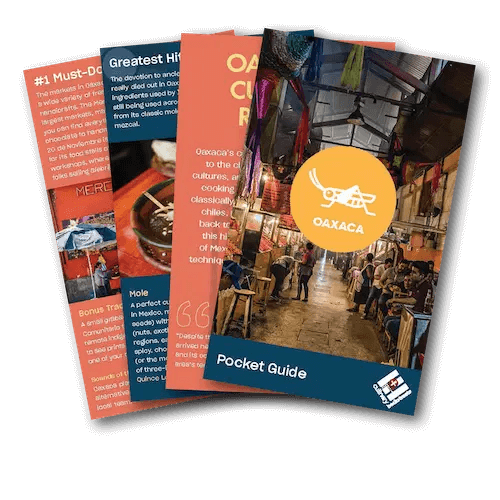
Get Your Free Oaxaca Pocket Guide
Introducing our pocket-sized Oaxaca guide — perfect for your next culinary adventure. Yours free when you sign up for our newsletter.
Get Your Free Oaxaca Pocket Guide
Introducing our pocket-sized Oaxaca guide — perfect for your next culinary adventure. Yours free when you sign up for our newsletter.
Immersive Multi-Day Journeys In and Around the World’s Culinary Capitals
Upcoming trips beyond Oaxaca
Visual Dispatches from the Frontlines of Local Eating
Oaxaca Videos

Discover the Culinary Backstreets of Oaxaca

La Cocina de Frida
Culinary Backstreets® Envoys, Always Searching for the Next Hidden Gem
Meet Our Oaxaca Team

María
Correspondent and Tour Leader

Luis
Tour Leader

Luis Pablo
Tour Leader

Veronica
Tour Leader

Ricardo
Tour Leader

Jalil
Photographer and Tour Leader

América
Tour Leader
Your Questions, Answered
Oaxaca is a city in the southern region of Mexico, six hours south of Mexico City. It is in a valley surrounded by different mountain chains that go all the way through the country to the Pacific Ocean. This particular geography makes it the culinary heart of the country, as the mountains hold different landscapes with all sorts of climates. It is also the birthplace of some of the most respected Mexican painters and politicians.
One of the most famous dishes in Oaxaca city is Tlayuda It is a crispy, 30-cm folded crispy tortilla with black bean paste, string cheese, cabbage, avocado, salsa and grilled meat (beef or chorizo) and pork lard (both of which are optional). Mornings cannot go by without a hot water chocolate with a piece of egg yolk bread and some memelas, enfrijoladas or entomatadas. Oaxaca is also famous for its seven varieties of mole, which you should definitely try, at least the yellow, the black and the green one. Make sure to add snacks in between meals: some plain grasshoppers and roasted garlic with a glass of beer or a mezcal. The sherbet-like ice creams and fruit-flavored waters are always a good option on spring and summer days.
Americans are welcome in Oaxaca, there are no special visa or Covid requirements in place for short-stay tourists.
Although the center of Oaxaca is mostly flat, with the exception of the steep streets surrounding it, the city is not very stroller-friendly. It does have an interesting offer of libraries for children and a couple of plazas and parks that have space for kids to run, or enjoy the small but lovely public playground. High seasons (Holy Week, Guelaguetza, Day of the Dead and Christmas) can get extremely crowded, but the rest of the year the amount of people walking and enjoying the city is far from overwhelming.
Oaxaca city is most famous for mezcal, food, art and the impressive diversity of indigenous cultures and languages, as it is the most diverse state in the country. It also has some impressive desert-like landscapes like the petrified waterfalls of Hierve el Agua, which are a type of mineral hot spring. Its historic sights trace the story of the city, from the native old ones like Mitla and Monte Alban, to the impressive baroque colonial churches, like Santo Domingo. In Oaxaca, celebrations are an everyday thing. The city is always witness to parades and musical performances, all of which is complemented by the bohemian ambiance found in the streets all day long. Nightlife can be even more lively, with dancing and art events spiced by the flavors of mezcal.
The best time to visit Oaxaca City is August to February. This long period of the year is ideal at any point, as Oaxaca seems to live under a perpetual spring. August is warm and fresh with rain, while autumn (September-December) and winter (January-February) have lovely weather with sunny days that aren’t too hot, and cool nights.
It is relatively easy to fly into Oaxaca City, it all depends on your origin city. While there are direct flights from Houston, Dallas and Los Angeles, most international flights require connections through a bigger city. You can either fly into Merida, Cancun, Guadalajara or Mexico City, and then fly directly to Oaxaca. Make sure to check the flights, as some of these destinations only offer one direct flight into Oaxaca. Once in Oaxaca’s airport, the best way to go to the city is by either the collective airport shuttle or in private taxis. You will find them waiting for the passengers right in the parking area of the airport.
Options in Oaxaca city are countless, but some of our favorite spots are as follows. For breakfast: the Sanchez Pascuas or the Merced Markets, as well as the Memelas de San Agustin street stall, Pan con Madre and Oscuro Brebaje Café. Lunch can be super exciting if you make sure to visit Levadura de Olla, or a great lunch street stall, the tacos del Carmen. For dinner, make sure to visit Ancestral, Origen, or Crudo.
The state of Oaxaca has breathtaking beaches that open into the Pacific Ocean. Warm emerald waters wait for you at the end of a windy road of dreamy cloud forests. Some of of these beautiful tropical spots are Puerto Escondido, Huatulco, San Agustinillo and Mazunte. You can get to many of these in 6 hours by car or 8-12 hours by public transport. There are also a couple of direct 30-min flights in a small airplane, but tickets’ prices can fluctuate considerably due to the scarce offer vs demand. Another good option is to fly to the Oaxacan coast directly from Mexico City.
Generally, the climate in Oaxaca City is sunny and dry, with some windy afternoons almost all year long. In autumn, the weather is sunny and slightly more humid, and temperatures range from 70 to 55 F. While winters can be a bit cool, it’s still sunny – not so different from autumn. Summers are more humid, and we can have some heavy rains or spontaneous but intense showers. Summers are hot if there isn’t enough rainfall. If going during March to early June, we recommend taking an umbrella or a hat, or anything that will protect you from the sun, as well as sunblock and clothes that will keep you cool.
Just like the rest of Mexico, Oaxaca City has quite a high vaccination rate of about 65-75%. There are no official mandates in place, but some shops, galleries and other spaces require the use of masks indoors. Using the mask in the streets is optional and many people still choose to do it. There are no further requirements for traveling to Mexico or Oaxaca.
In general, Oaxaca is a very safe city. Like in any place in the world, if you are not looking after your belongings or you are displaying expensive photographic equipment, you can always get undesired attention. In general people are friendly and a smile and polite words will always get you far.
The Historic Center and the neighborhoods of Jalatlaco and Xochimilco are the best areas to stay in Oaxaca City when you are visiting for the first time. They are close to most restaurants, shops, cafes, historical sites, galleries and nightlife, and they are well connected in terms of transportation. However, if you are acquainted with the city, you might want to explore the northern areas of San Felipe and Colonia Reforma. These two neighborhoods are quieter than the centro and have interesting markets and spots to explore. San Felipe is closer to nature and a lot of people often rent cars to move across the city. Colonia Reforma has the best of two worlds: It is close enough to the center, but also close enough to San Felipe’s green areas and main routes to some of the most interesting villages and nature around the city.
Prices in Oaxaca are usually lower than in big American cities, though this varies widely. Markets are cheaper than touristic or high-end places. The average price of a 3-star hotel is about $50, a cup of coffee or beer under $2, and a sit-down dinner can run anywhere from $12-50. The street food offer, for example, is superb, and prices are considerably lower than restaurants. While the historic center of Oaxaca is relatively small and most things are within walking distance, taxi fares start at a minimum of $3.


